Location
Our Washington Location
Our inpatient facility is located in Washington, and will serve Washington state. It will provide a safe & therapeutic environment for both our staff and patients.
- Edmonds
7416 212th St SW,
Edmonds, WA 98026

Disclaimer: This article is not intended as a substitute for the counsel of a qualified physician or licensed therapist. This content should be used for purely informational purposes. Please consult your doctor if you have further inquiries on this subject. We intend to impart the most accurate and recent information but cannot make any guarantees.
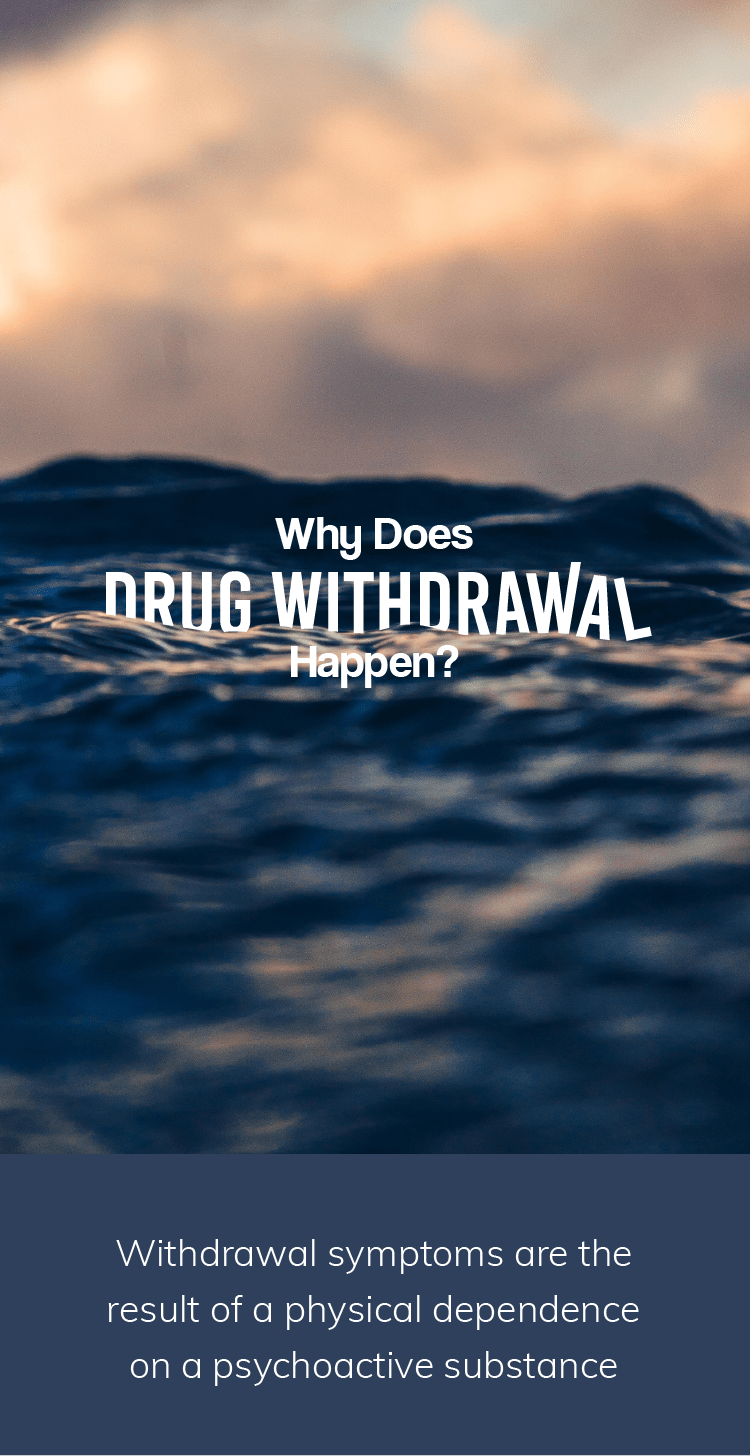
That feeling of ants crawling under your skin. The sweating, the vomiting, the shakes - no matter how drug withdrawal presents itself, it is an agony that no one wants to endure. If you've been through it, then you already know. The looming dread of oncoming withdrawals can itself be enough to keep you using. Anything to fend off the racking physical and emotional pain that you know awaits when you put down the needle, the pills, the pipe, the bottle...
But there's no avoiding it.
Anyone who has drug or alcohol abuse problems knows that once a firm addiction has set in, there are only two possible outcomes at the end of it all - withdrawal or death.
Yes, this sounds dreary and tragic, but it is not all darkness and nightmares. There are new advancements in detox treatments being developed on the daily, and if you are well-informed and well-prepared, drug withdrawal can be endurable. Sift through the article below to find out all of the nitty, gritty details associated with specific types of drug withdrawal. The more you know about the symptoms and risks of drug or alcohol withdrawal, the more prepared you'll be to undergo the process in the safest, least painful way possible.
Everyone knows that addiction and withdrawal go hand in hand, but the reasons behind this phenomenon are bit more complicated.

Withdrawal symptoms are the result of a physical dependence on a psychoactive substance. This is how a physical dependence would form if you were to abuse drugs or alcohol over time:
There you have it - the slippery slope of dependence that results in withdrawal. Once addiction has taken hold, quitting will cause your body go through withdrawal until it restores a healthy chemical balance. There's simply no avoiding it.
"It feels like I'm dying."
This phrase is commonly spoken by people going through a cold-turkey detox. Sometimes, drug withdrawal symptoms are so painful or emotionally difficult that you may become scared for your own physical well-being. In some extreme cases, drug withdrawal can present a real physical danger, but most of the time, this debilitating fear is one of the ways that the brain tries to convince you to use again. This self-sabotage may be unconscious but unfortunately, it often leads to relapse.
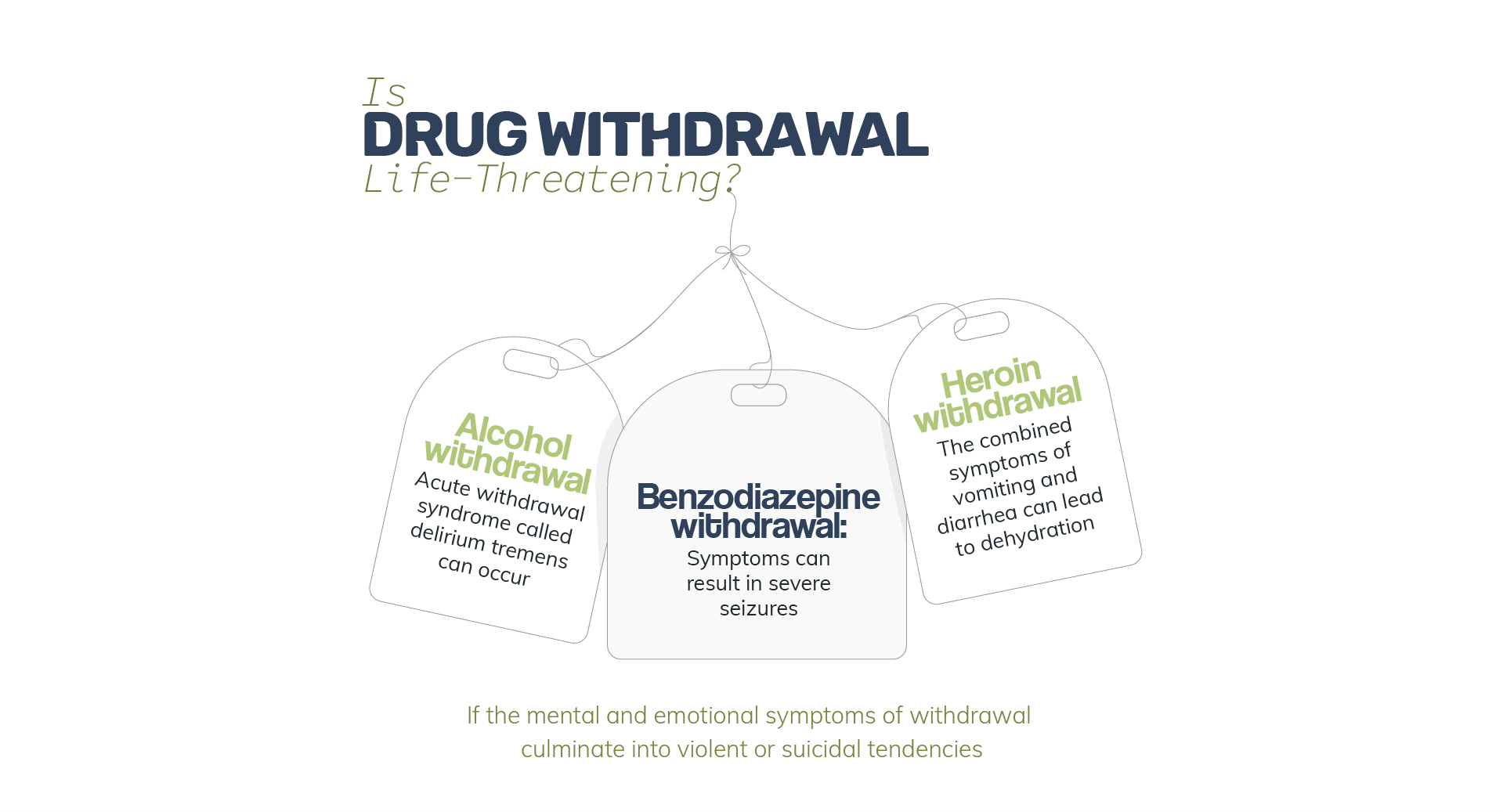
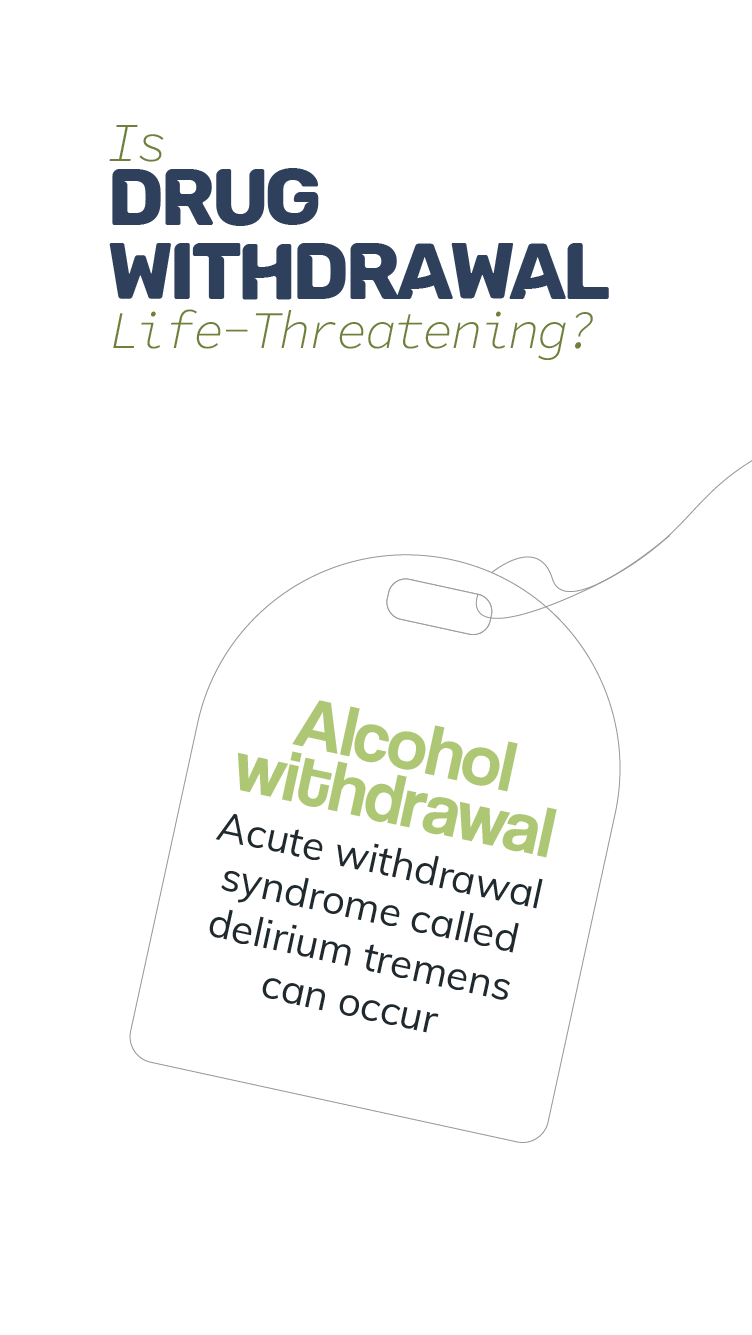
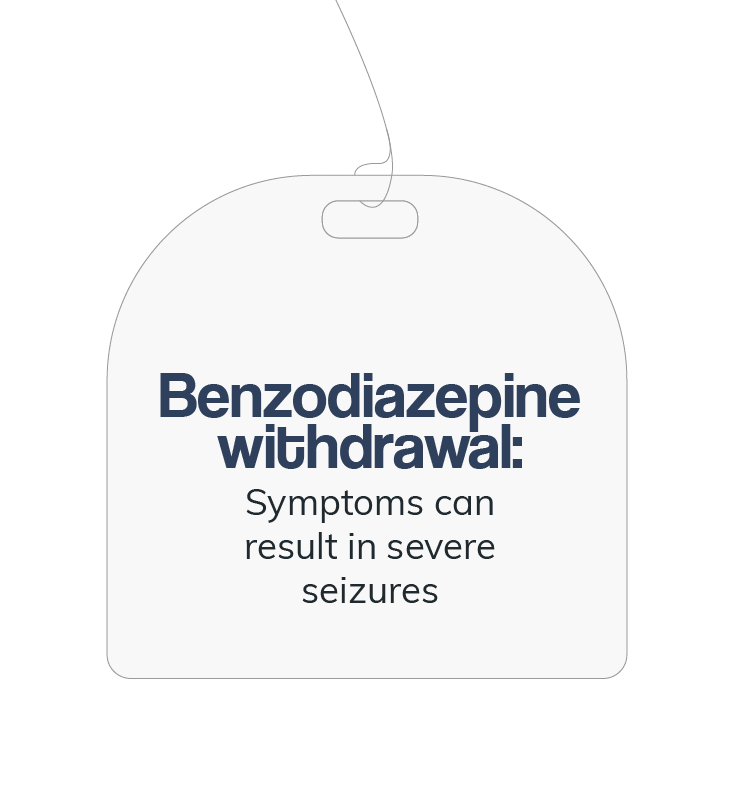
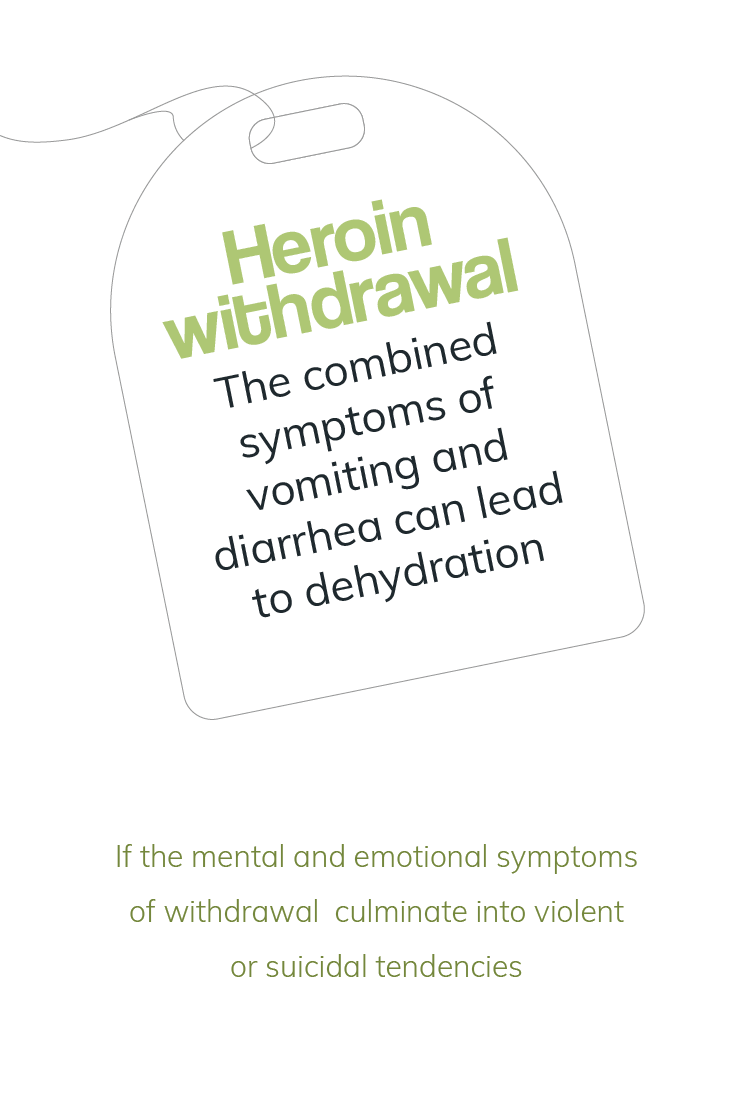
These are the rare cases in which drug withdrawal may actually be life-threatening:
Below, we will lay out some of the red flags and danger signs to be aware of during the different kinds of drug withdrawal, just in case. Although drug withdrawal is not usually life-threatening, it is very important never to go through it alone or unsupervised because of the dangers mentioned above.
On one hand, alcohol is in a class all its own, but it is also considered a depressant because of its depressive effects on the Central Nervous System (CNS).
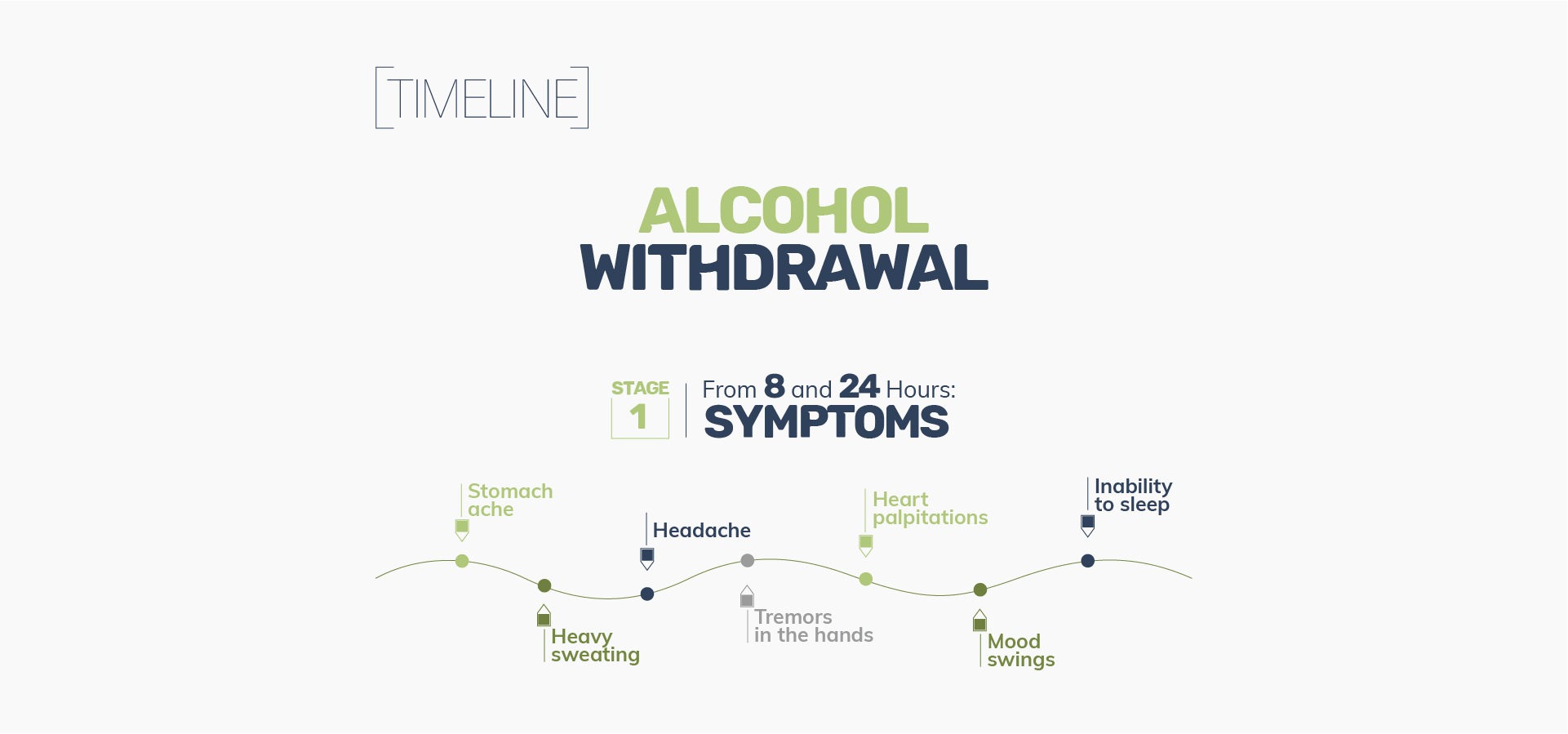

Alcohol has a history that goes back as far as written records exist, although it may have found its beginnings in ancient Egypt, China, or Greece. Since then it has pervaded every single civilization in some form. Alcohol is the most commonly abused drug in the United States.
Warm, happy elation. Sedation and a loss of inhibition.
Alcohol withdrawal lasts about seven days on average but may vary according to the length and severity of alcohol abuse. It will look something like the following.
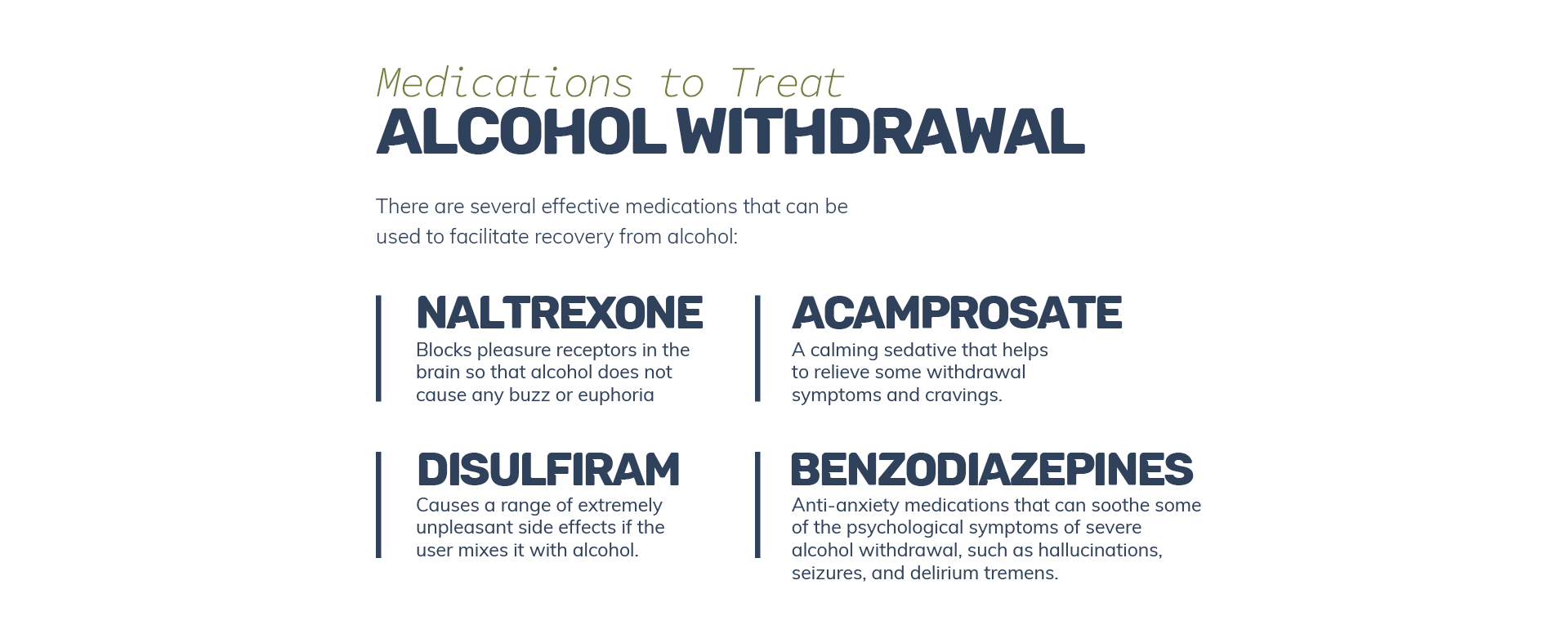
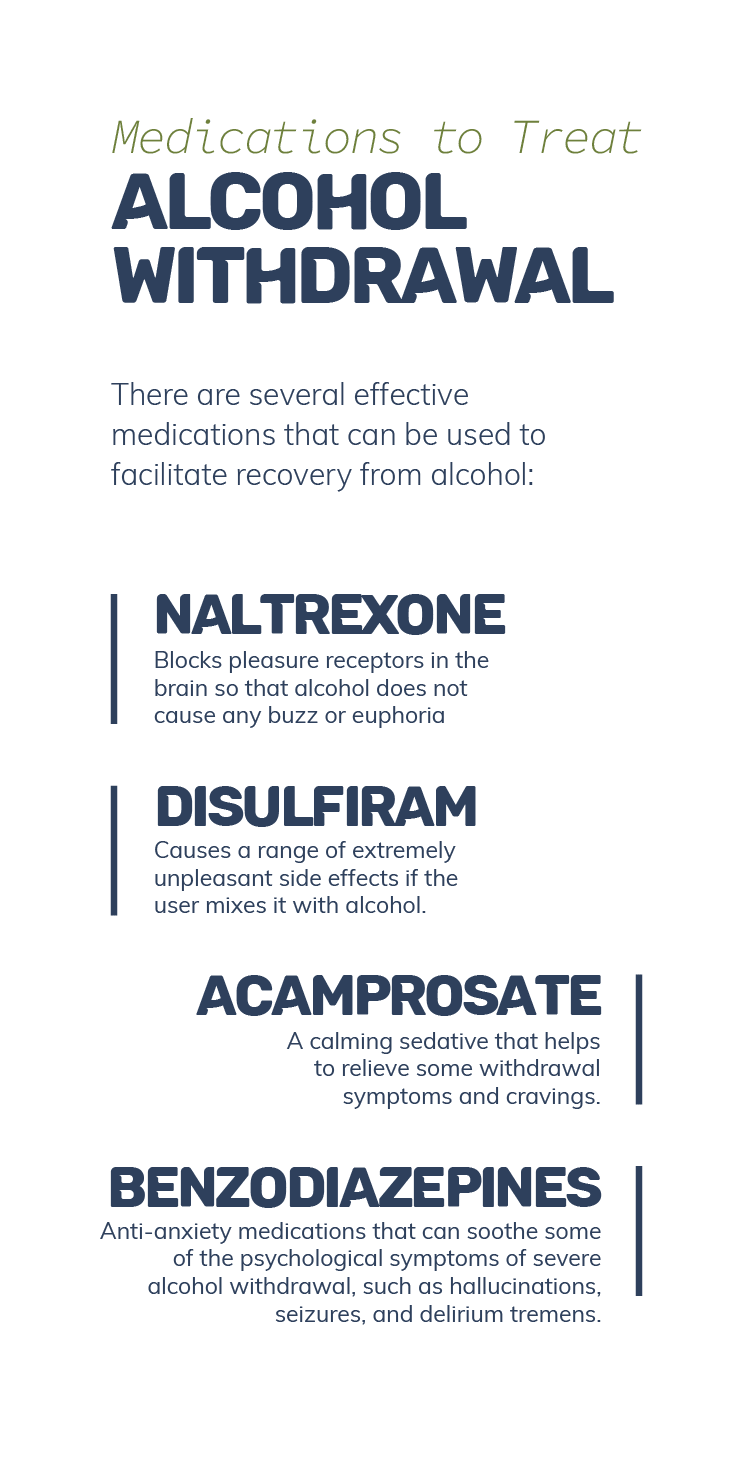
Stage One - Between 8 and 24 Hours:

Stage Two - Between 24 and 72 Hours:
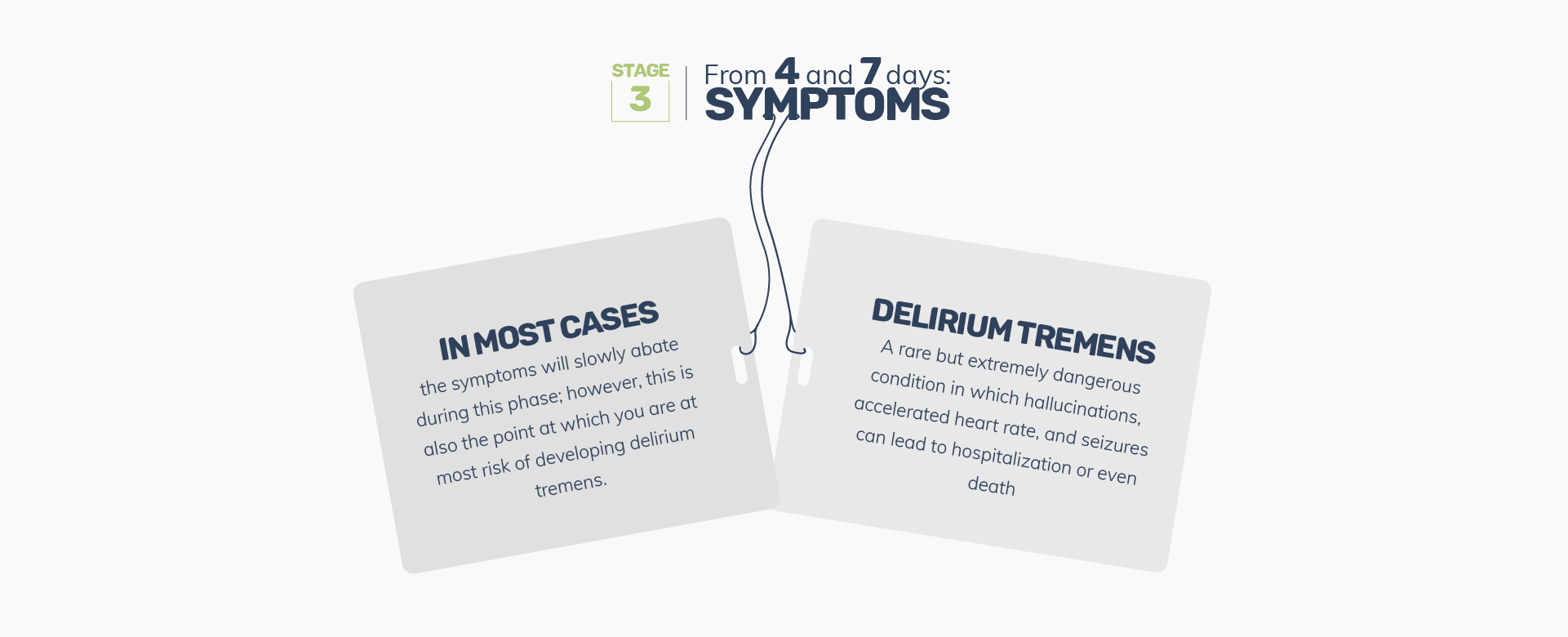
Stage Three - Between 4 and 7 Days: In most cases, the symptoms will slowly abate during this phase; however, this is also the point at which you are at most risk of developing delirium tremens.
Delirium tremens is a rare but extremely dangerous condition in which hallucinations, accelerated heart rate, and seizures can lead to hospitalization or even death.
If you or someone you know is going through alcohol withdrawal and suffers any of the following symptoms, call 911 or go straight to the emergency room:
There are several effective medications that can be used to facilitate recovery from alcohol:
The alcohol half-life is about 30 minutes for every ounce of alcohol. This means that you'll stop feeling the effects after one hour, but that's for each ounce. Every additional ounce will add to the effects and the length of time that it stays in your system.
The most common form of alcohol testing method is the breathalyzer, which detects the amount of alcohol currently active in your system. For this reason, it can detect alcohol for about an hour after each ounce you drink. If you were to drink 8 ounces within a one-hour period, then the breathalyzer would detect the presence of alcohol for about 8 hours afterward.
Traditional forms of drug testing can also detect alcohol:
Cannabis is in a class all its own called cannabinoid drugs.
With its oldest-recorded use in ancient China, the cannabis plant was originally cultivated for hemp to be used in ropes and textiles. It was used medicinally in Europe for centuries and only became popular in the USA as a recreational drug after it was outlawed in 1917. Then the PSA film Reefer Madness brought marijuana into the spotlight, only to be adopted by thousands of young people as the perfect way to stand up to "The Man". Today marijuana is once again becoming popular as a medicinal remedy.
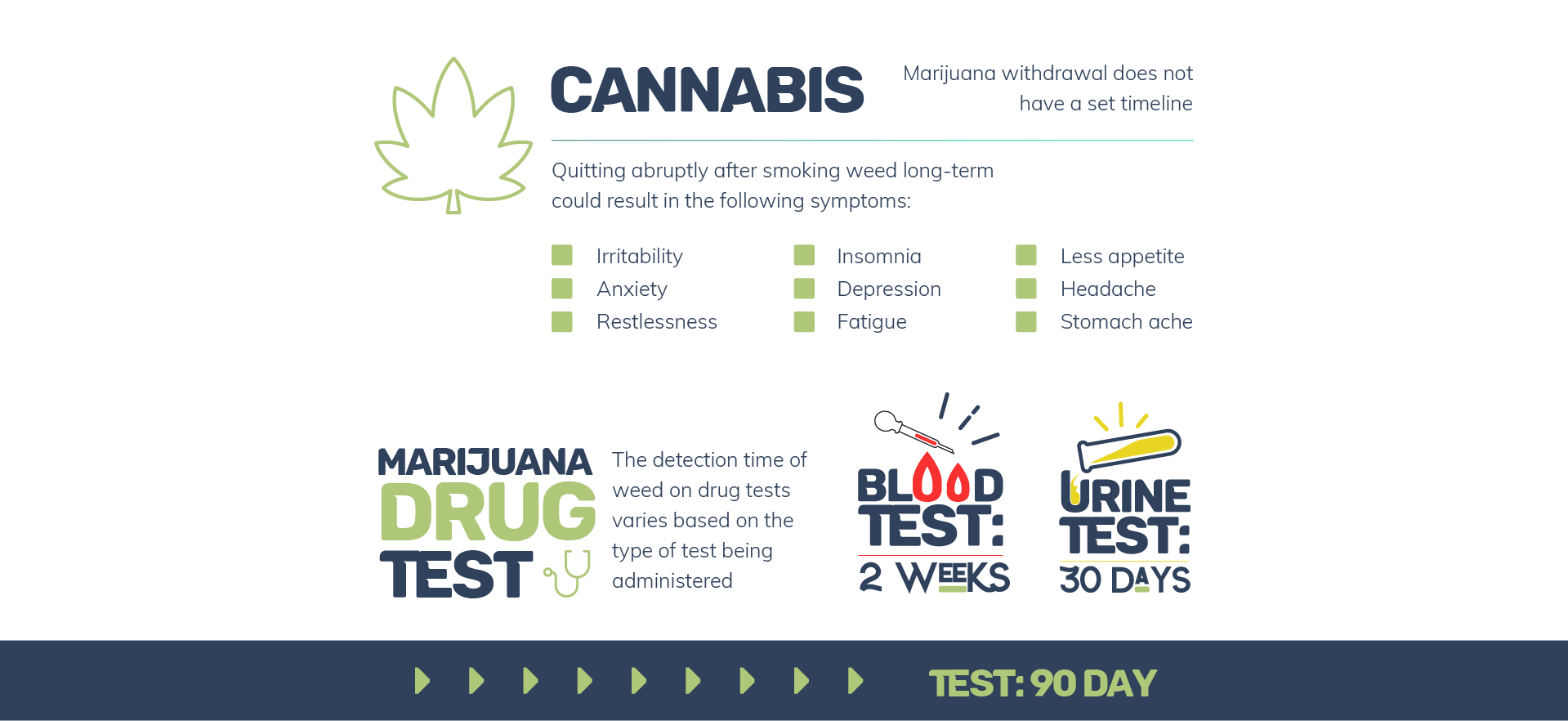
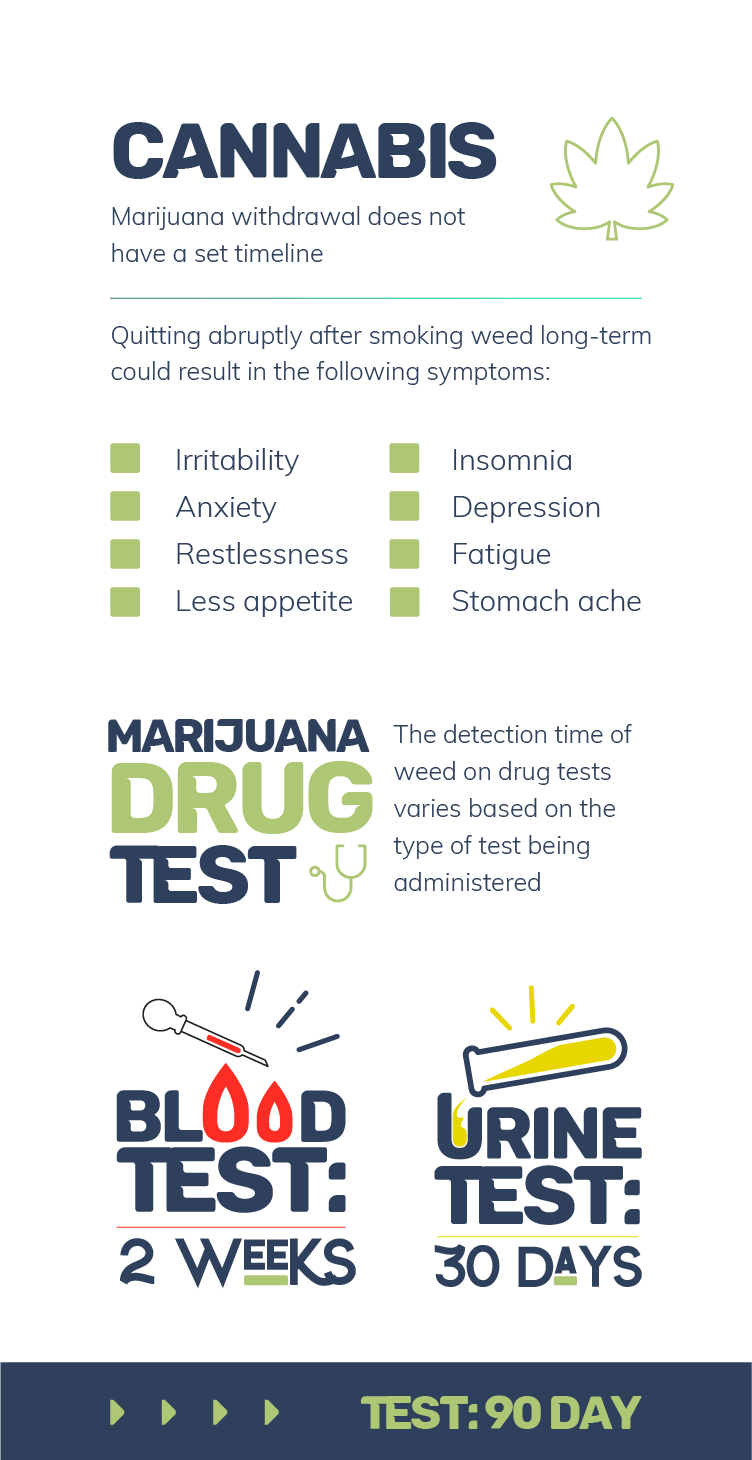
Depending on the consumer, relaxation or paranoia. Soft euphoria and altered sensory perception.
Yes, marijuana addiction is a thing, as is marijuana withdrawal. Marijuana affects pleasure centers and sensory perceptions in the brain and therefore, its continuous use can create both psychological and physical addiction. If you smoke weed long-term or very often, quitting abruptly could result in the following symptoms.
Note that marijuana withdrawal does not have a set timeline; this is because the active component of cannabis - delta-9 tetrahydrocannabinol(THC) - can remain active in the system for weeks. For this reason, weed withdrawal symptoms may continue for weeks or even months after the last dose, depending on the length and severity of the addiction.
Although no medications have been developed specifically to treat marijuana withdrawal, low doses of anti-anxiety meds like diazepam can help with the psychological side effects and insomnia.
We hear a lot of questions about how to pass a drug test for weed. The marijuana drug test is particularly difficult to get around because of how long weed stays in the system. The marijuana half-life is 2 to 4 hours, but its effects may continue for days after you ingest it. Unlike other drugs, THC is fat-soluble, which means your body stores it in fat cells for weeks longer than other substances. That's why it's detectable in marijuana drug tests for such long periods of time:
Stimulants are known for their combined effects of energy and pleasure. Some people like to take them to get a potent, short-lived high. Stimulants can make you feel powerful, confident, and smart. Other people take them purely for their stimulative energy-enhancing properties. These drugs can increase focus, keep you awake for hours or even days longer than usual, and generally make you feel energetic. Either way, this class of drug is dangerously addictive, wreaking havoc on the body and mind.
Cocaine is the most popular illicit stimulant in the United States.
The fine white powder was first synthesized from the coca plant by 19th-century chemists after they observed Amazonian tribes chewing coca leaves. When doctors failed to find any medical use for the drug, congress outlawed its use in 1917. Despite its illegal status, cocaine was used as a recreational stimulant occasionally in certain crowds during the mid-20th century but then exploded into popularity in the 1970s when South American cartels began importing it into North America en masse. Cocaine is largely responsible for America's ongoing War on Drugs.
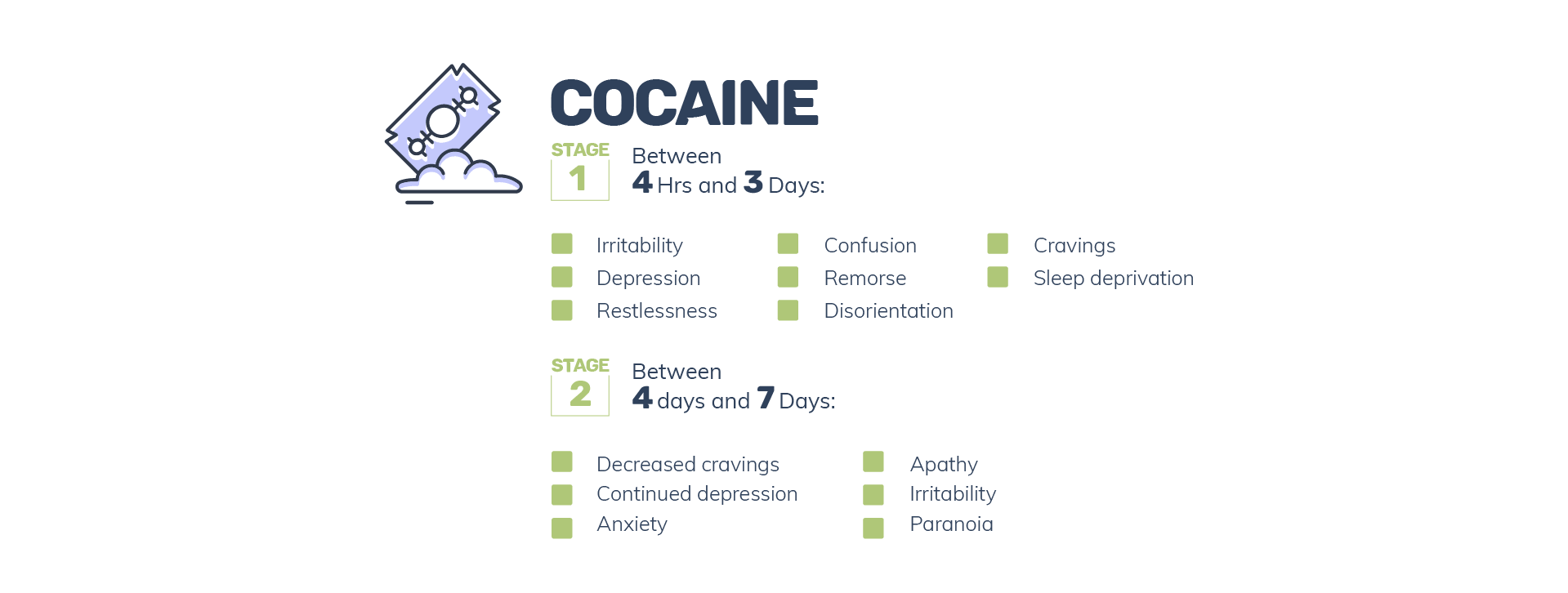

Rush of euphoric energy, sudden confidence, intense focus.
Cocaine withdrawal is primarily psychological, with symptoms like depression and anxiety that can be severe to the point of debilitation. This process is known to exacerbate co-occurring mental conditions like bipolar disorder, and cocaine detox may also last longer than other types of withdrawal, up to four or five weeks.
Stage One - Between 4 Hours and 3 Days:
Stage Two - Between 4 Days and 7 Days:
Stage Three - Between 2 and 4 Weeks:
After the first week has passed, cocaine withdrawal symptoms will fade gradually; however, some psychological side effects like depression, irritability, and anger may continue for several weeks more.
The dangers associated with cocaine withdrawal are usually attributed to extreme psychological side effects, but long-term cocaine or polysubstance abuse may also contribute to cardiovascular complications. Below are some danger signs to look for during cocaine withdrawal. If you notice any of the following symptoms, seek emergency medical attention right away:
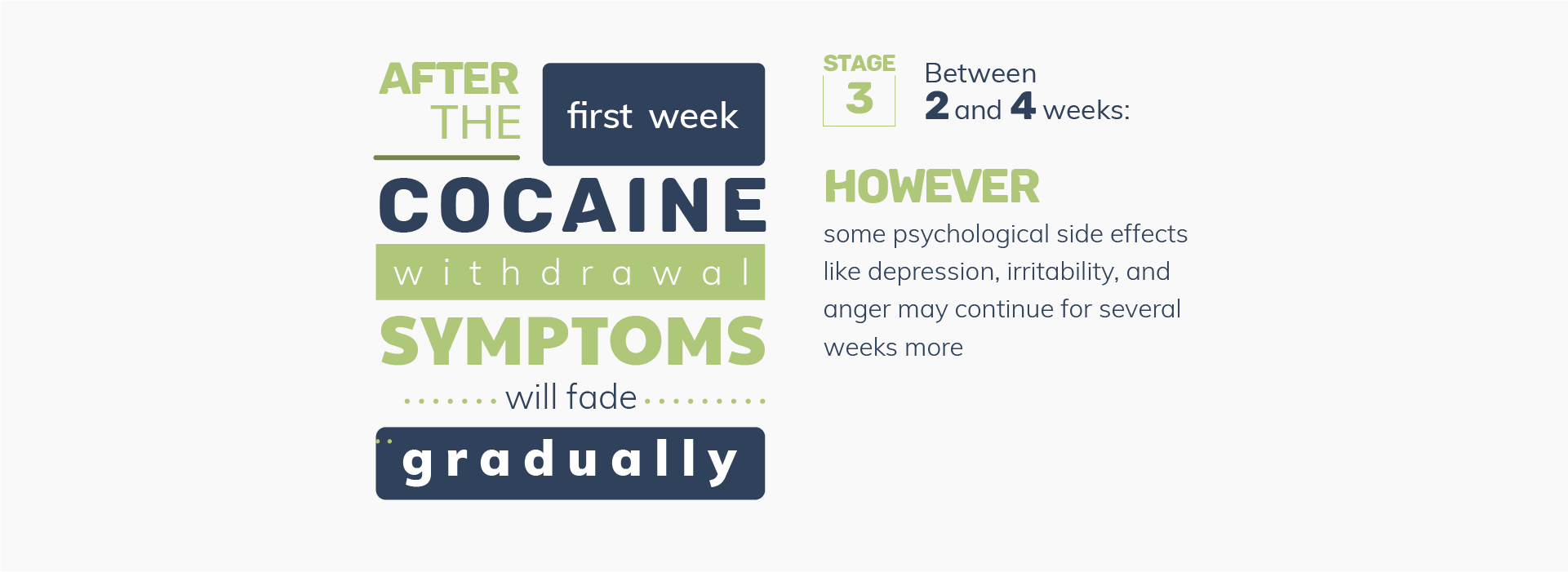
While there are no FDA-approved medications to treat cocaine withdrawal, some prescriptions can address certain symptoms:
Cocaine has an extremely short half-life of only 45 minutes, so it flushes out of the system fairly quickly:
Meth is one of the strongest stimulant drugs. Not only does it release huge quantities of happy dopamine chemicals, methamphetamine also release noradrenaline transmitters, which in turn cause a rush of energy and alertness.
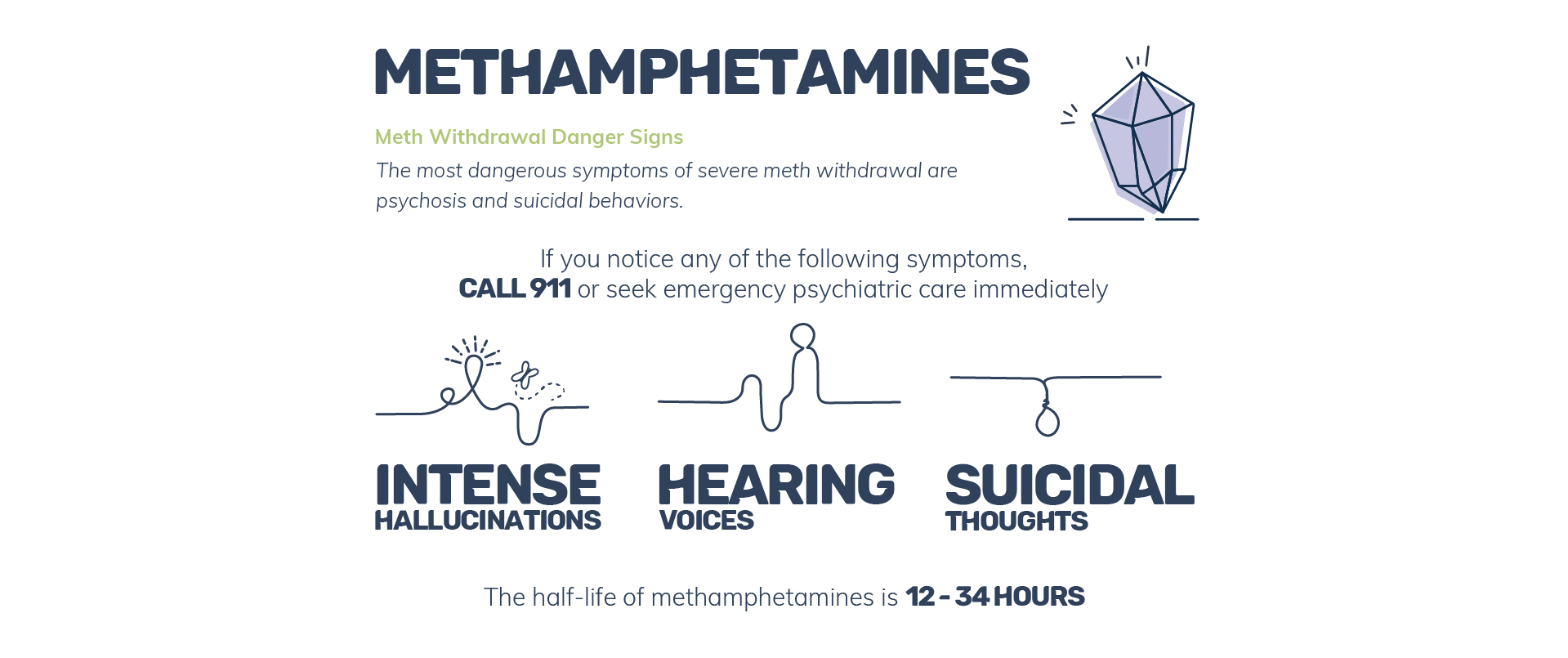

Methamphetamine was first synthesized in Japan back in the late 1800s, at which time it was used to treat obesity, narcolepsy, and asthma. United States World World II commanders discovered its usefulness in increasing alertness and productivity in soldiers, after which it hit the mainstream as a popular over-the-counter stimulant. It wasn't outlawed until the 1970s, but by then, the damage was done. Meth never lost its appeal as a stimulant, especially in rural communities.
Intense euphoria and alertness. A rush of compulsive, manic energy.
Meth withdrawal is more psychological than most other drugs and, in severe cases, may even result in debilitating psychosis that mimics symptoms of schizophrenia. This is the timeline:
Stage One - Between 1 and 3 Days:
Stage Two - Between 4 and 7 Days:
The most dangerous symptoms of severe meth withdrawal are psychosis and suicidal behaviors. If you notice any of the following symptoms, call 911 or seek emergency psychiatric care immediately:
There are no medicinal treatments that have been developed specifically to treat meth addiction, but there are some prescriptions that can reduce specific symptoms and cravings:
Meth is associated with a long-lasting high, which is not surprising considering the half-life of methamphetamines is 12 - 34 hours. This drug may show up in drug tests far longer than other stimulants because of this characteristic:

Adderall is a prescription stimulant that is less potent than illicit stimulants. It is primarily used for the treatment of Attention Deficit Hyperactivity Disorder (ADHD).
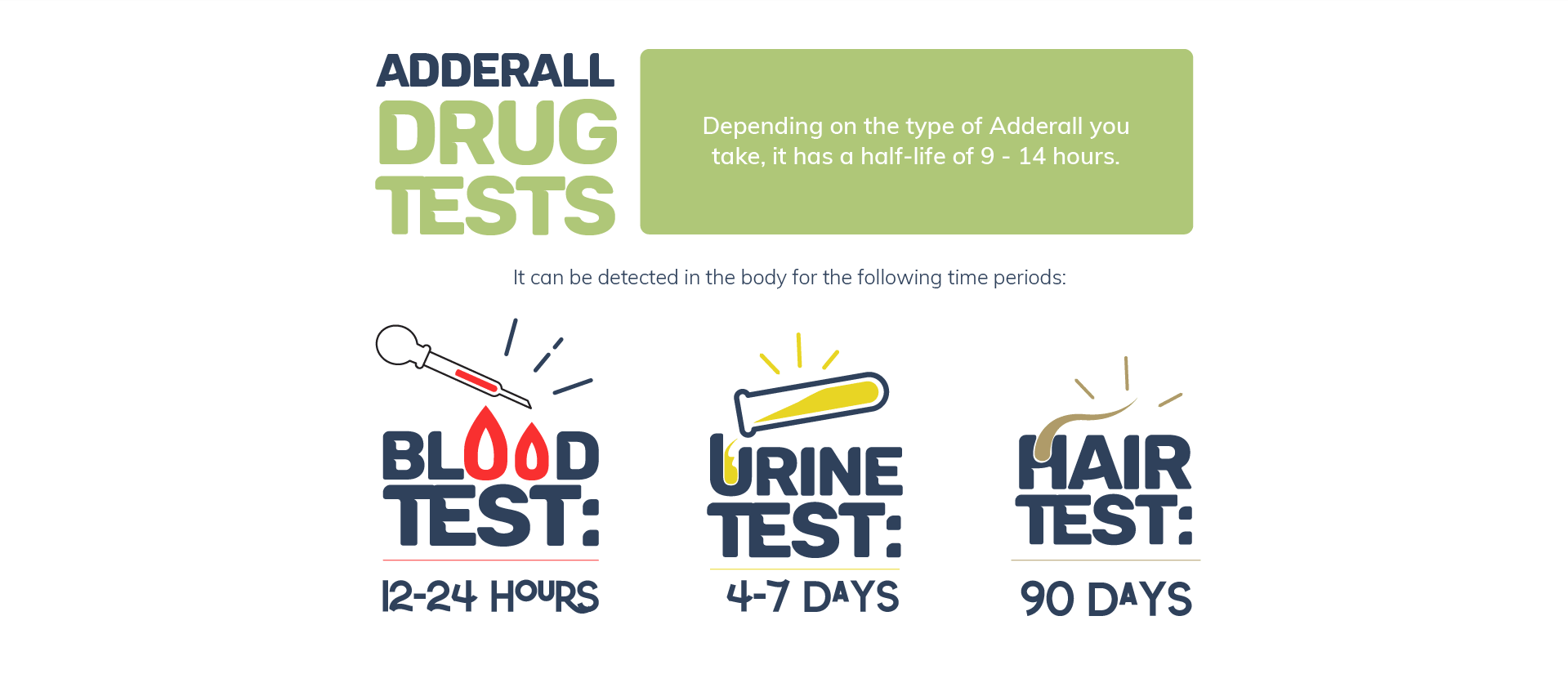

Adderall is manufactured from amphetamines, the same drugs that produced meth. In the early 20th century, they were used to treat conditions like obesity and asthma, but it wasn't long before users discovered their stimulant effects. By the 1950s, amphetamine was popular for use as a "study buddy" for students or as a way for blue-collar workers to remain awake during night shifts.
It wasn't until the 1980s that psychiatrists discovered the benefits of amphetamines to treat ADHD. Since then this has been its sole use, although Adderall continues to be abused as a study aid and wakefulness stimulant.
(If abused) Mild euphoria, jitters, enhanced focus and concentration.
The withdrawal symptoms of Adderall are similar to but milder than those caused by illicit stimulants:
Stage One - Between 1 and 2 Days:
Stage Two - Between 5 Days and 2 Weeks:
Stage Three - Between 3 Weeks and 3+ Months:
Some psychological symptoms may persist intermittently for weeks or even months after you stop using, especially if Adderall was abused for more than a year.
Depending on the type of Adderall you take, it has a half-life of 9 - 14 hours. It can be detected in the body for the following time periods:
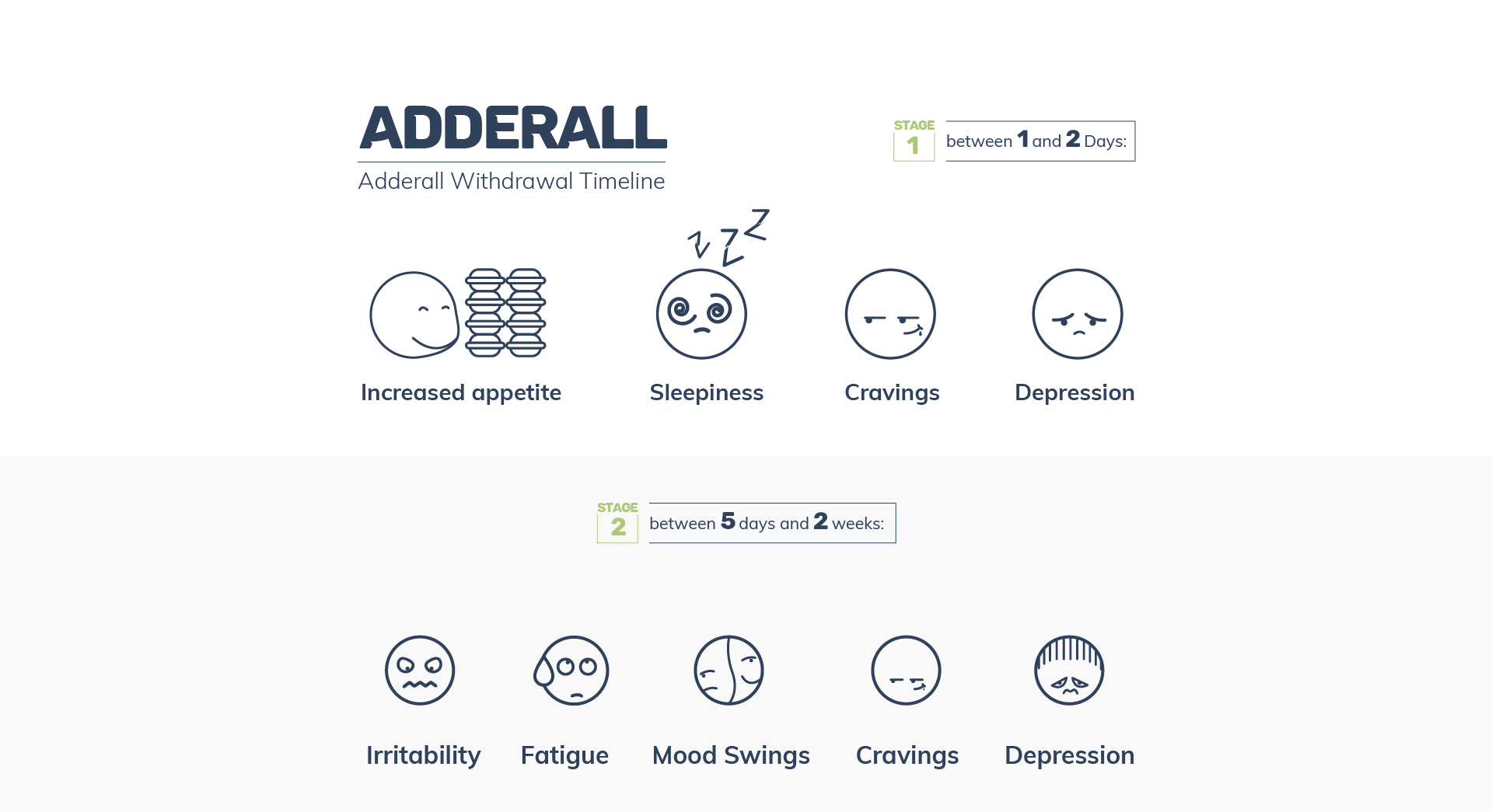
Opioids are considered by most to be the most addictive type of drug; one reason for this is the intense, blissful euphoria produced by this class of substance. These drugs are also known for the sheer misery caused by opioid withdrawal. Opioid withdrawal is famously difficult, which is another contributing factor to addiction and relapse.
Heroin is one of the most potent and most dangerous forms of opioid. Since it has no medical uses, heroin can only be purchased on the street, usually in a highly diluted form that is mixed with any number of fillers or toxins.
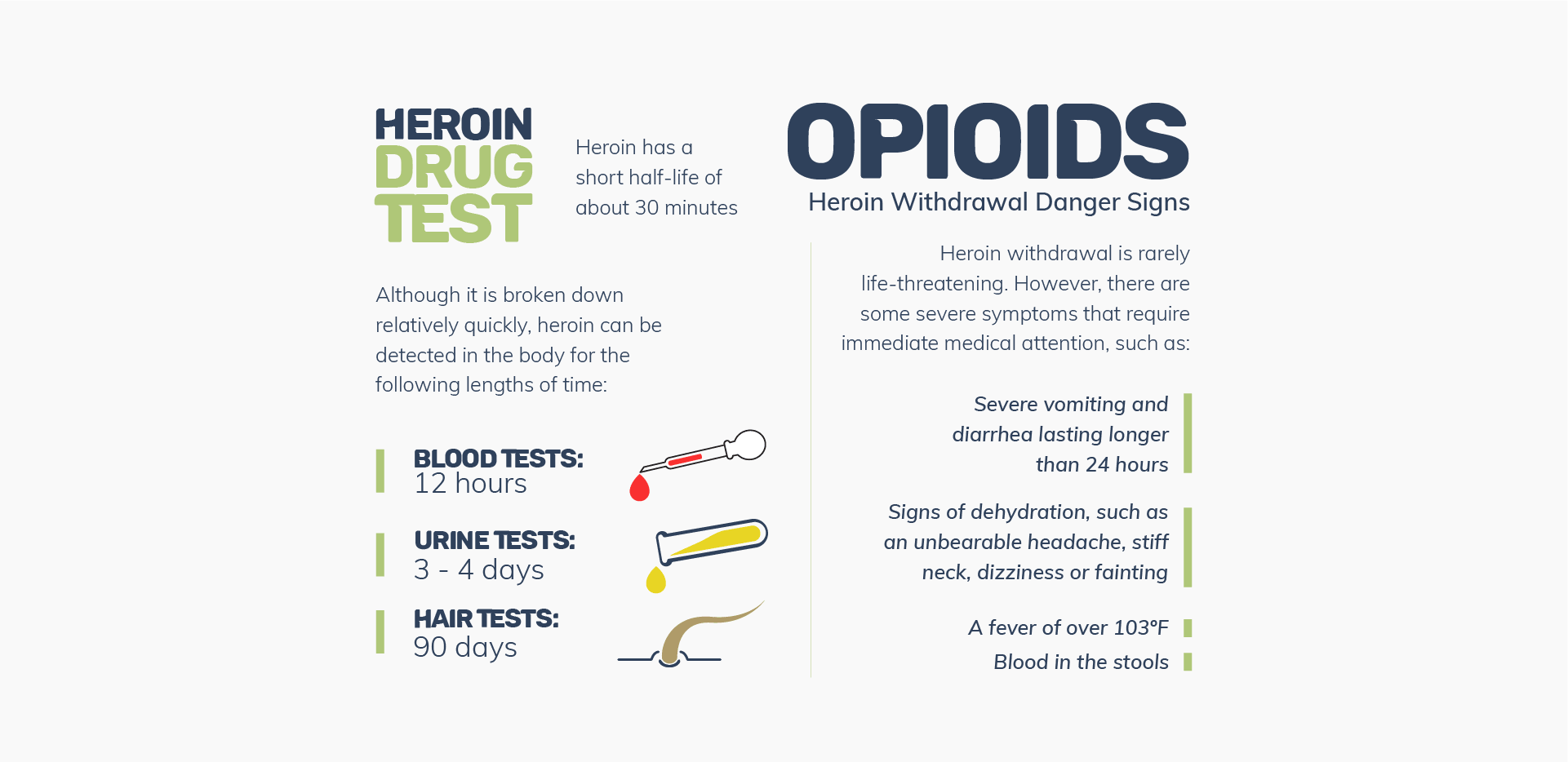
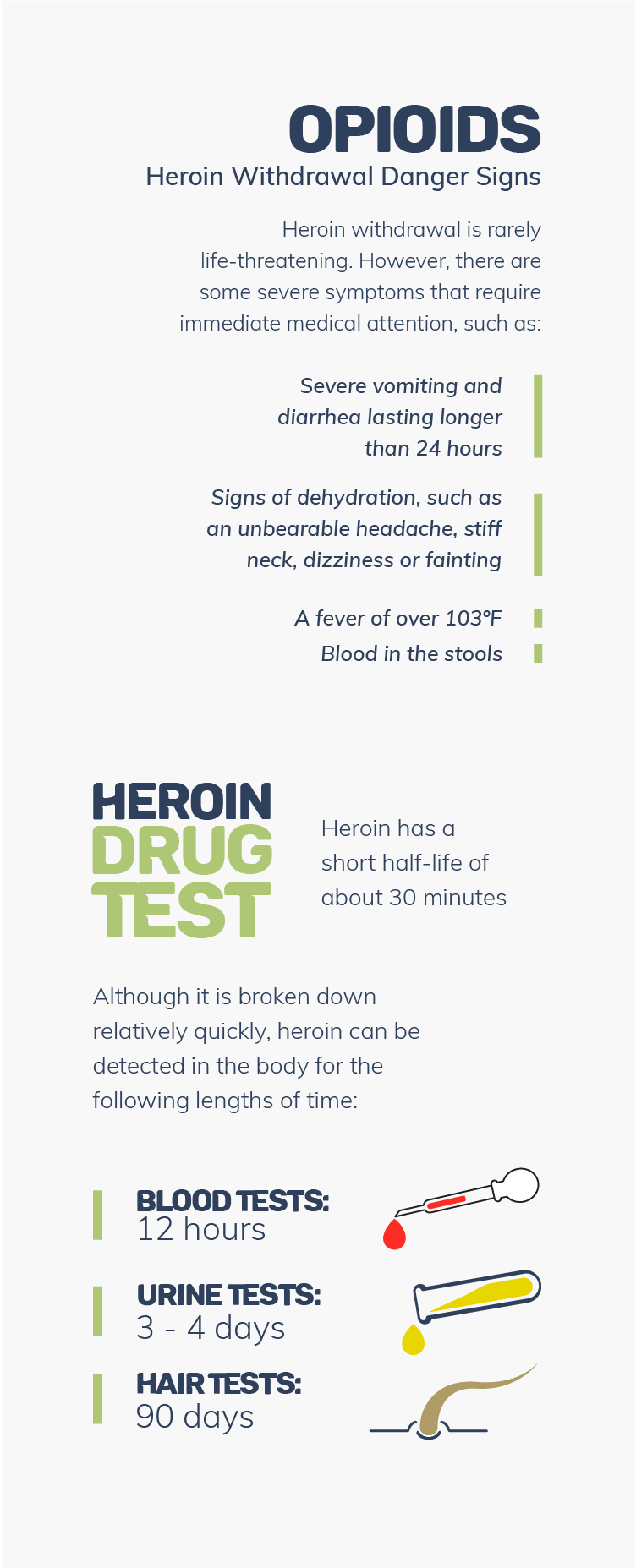
Although heroin is technically derived from morphine, all opioids have their roots in opium - an age-old drug that is extracted from the opium poppy flower. Opium and its derivatives have been used as a remedy for pain for much longer than the existence of written records, but its intoxicating pain-soothing properties have always made the drug popular for abuse.
A warm, blissful euphoria that overpowers the mind and senses.
Since heroin has a very short half-life and wears off quickly, withdrawal symptoms can begin within hours of the previous dose. Here is a general timeline:
Stage One - Between 6 and 12 Hours:
Stage Two - Between 1 and 3 Days:
Stage Three - Between 3 and 7 Days:
Some symptoms of heroin withdrawal, such as insomnia and depression, may last for several weeks more.
Heroin withdrawal is rarely life-threatening (although it may certainly feel that way), but there are some severe symptoms that do require immediate medical attention, such as:
Heroin withdrawal doesn't have to be as severe and difficult as the timeline above implies. This is one drug that has been studied extensively; a variety of clinically tested and FDA-approved medications exist to help patients endure heroin withdrawal:
Heroin's short half-life lasts only about 30 minutes, but the drug's effect may continue to be felt by the user for several hours after taking it. Although it is broken down relatively quickly, heroin can be detected in the body for the following lengths of time:
Fentanyl is an incredibly strong synthetic opioid which may be up to 100 times more potent than morphine.
Because its potential for abuse and overdose has always been well-known, fentanyl was used only under strict medical supervision until its patent expired in 1981. After that, illegal drug labs learned how to synthesize the substance relatively quickly and began to sell it on the street.
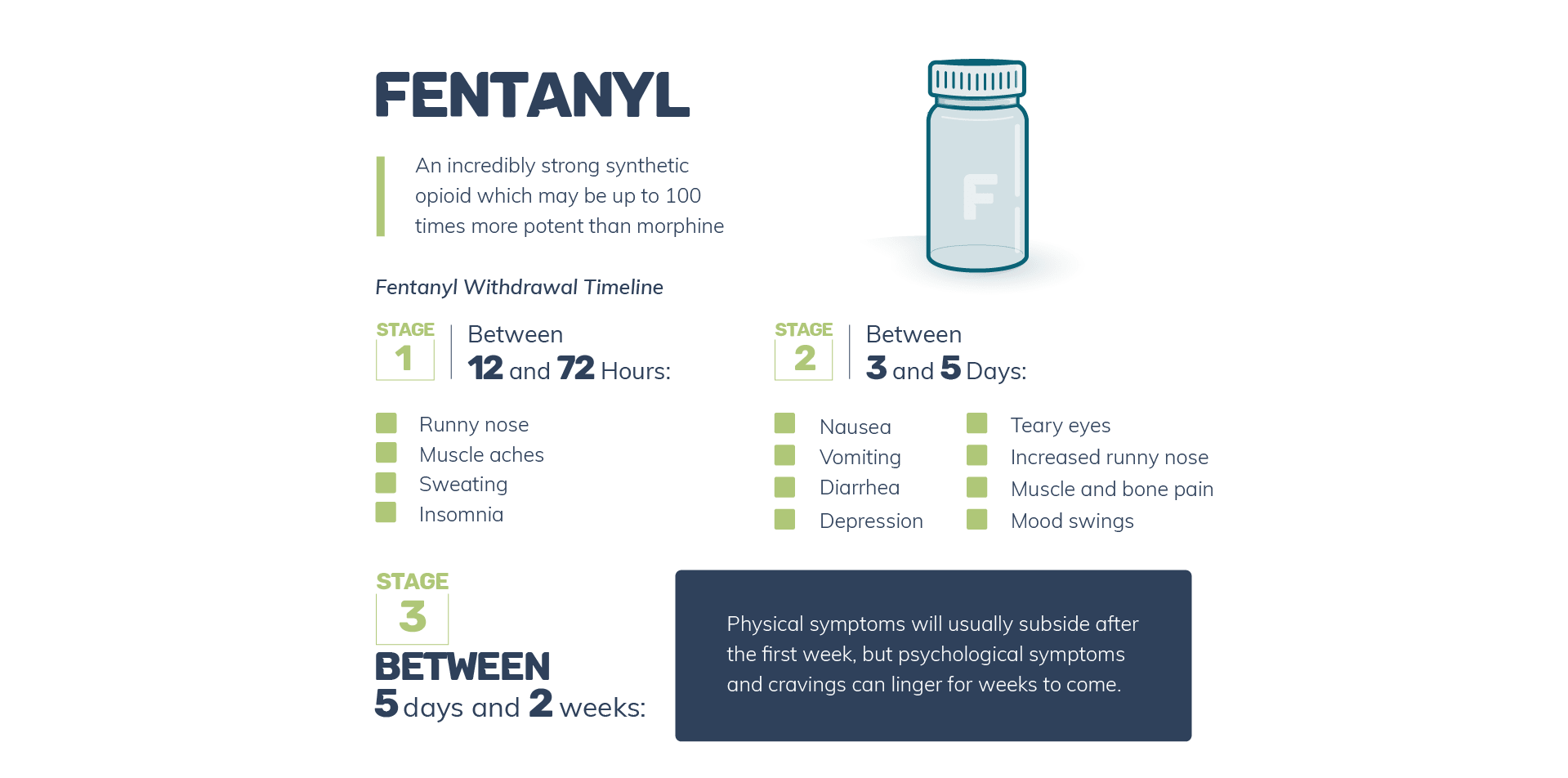

Today, fentanyl is still sold illegally on the street, although most illicit drug users are aware of its dangerous potential for overdose; many avoid the drug. Perhaps more alarming than the drug's potential for overdose is the fact that it is often cut into illicit street drugs like heroin and cocaine. Unfortunately, many fentanyl overdoses are the result of such practices; users do not even realize they are taking volatile fentanyl doses when they consume other fentanyl-laced street drugs.
Intense euphoria and relaxed happy sensations
Stage One - Between 12 and 72 Hours:
Stage Two - Between 3 and 5 Days:
Stage Three - Between 5 Days and 2 Weeks:
Physical symptoms will usually subside after the first week, but psychological symptoms and cravings can linger for weeks to come.
The danger signs for fentanyl and any other opioid are the same as those for heroin. See above.
The medications used to treat fentanyl withdrawal will be those same medications used for heroin withdrawal. See above.
The half-life of fentanyl varies widely between its medical applications. If taken orally, it has a half-life of 5 - 14 hours; intravenously, the half-life will be 2 - 4 hours; and transdermally (through a skin patch), the half-life is about 17 hours. Regardless of how the drug is delivered however, detection times will remain much the same:

Oxycodone is a semisynthetic opioid that is derived from opium, like morphine.
This drug was first synthesized in 1916 in an effort to develop pain-relieving medications that were not addictive. In this effort, German scientists failed, but the substance was used to develop painkillers like Percocet and Oxycontin. Although both of these medications undeniably work to reduce pain, they also both played a role in the opioid epidemic that has taken hold of the United States today.
Feelings of invincibility paired with strong euphoria
Stage One - Between 12 and 48 Hours:
Profuse sweating
Runny nose
Symptoms similar to cold or flu
Muscle pain
Diarrhea
Loss of appetite
Trouble sleeping
Anxiety
Stage Two - Between 3 and 5 Days:
Goosebumps
Shivers
Abdominal cramping
Vomiting
Lack of appetite
Insomnia
Stage Three - Between 5 Days and 2 Weeks:
Most withdrawal symptoms will fade during this interval, although psychological symptoms could linger for some time.
The danger signs for oxycodone and any other opioid are the same as those for heroin. See above.
The medications used to treat oxycodone withdrawal will be those same medications used for heroin withdrawal. See above.
The half-life of oxycodone changes according to which type of pills you are taking. Percocet has a half-life of 3 hours while the half-life of slow-release Oxycontin is closer to 4 or 5 hours. Detection of the substance in the body will be similar for both, however:
Methadone is a synthetic opioid used specifically for the treatment of opioid addictions.
Methadone, like oxycodone, was developed by a team of German scientists searching for non-addictive pain treatments. Although methadone can be addictive, if taken in low doses it does not cause a euphoria comparable to morphine and other opioids. In the 1960s, it was clinically tested as a way to reduce withdrawal symptoms and heroin cravings without bringing on a full narcotic high. By the 1970s it was being used internationally as a treatment for opioid addiction.
Morphine is still the most common form of opioid replacement therapy for addiction, but is criticized by many for its potential to result in addiction or overdose.
When abused, methadone can bring on a sedated, relaxed euphoria.
Quitting methadone cold turkey is not usually recommended, but if it is stopped suddenly, the withdrawal process will look like this:
Stage One - Between 12 and 48 Hours:
Stage Two - Between 2 and 10 Days:
Stage Three - Between 11 Days and 4+ Weeks:
The danger signs for methadone and any other opioid are the same as those for heroin. See above.
Since methadone is technically already a medication to ease opioid withdrawal, many criticize the use of other potentially addictive substances to treat methadone withdrawal. Usually the process involves a slow tapering of the drug until it is no longer needed.
There is some evidence of the successful use of buprenorphine to ease methadone withdrawal symptoms, although the practice is not common.
The half-life of methadone is long - about 15 hours. It can also be detected in the body for longer than most other opioids:
Suboxone is a combination of naloxone and buprenorphine - a mild semi-synthetic opioid that is less likely to be abused than methadone or other more potent opioids.
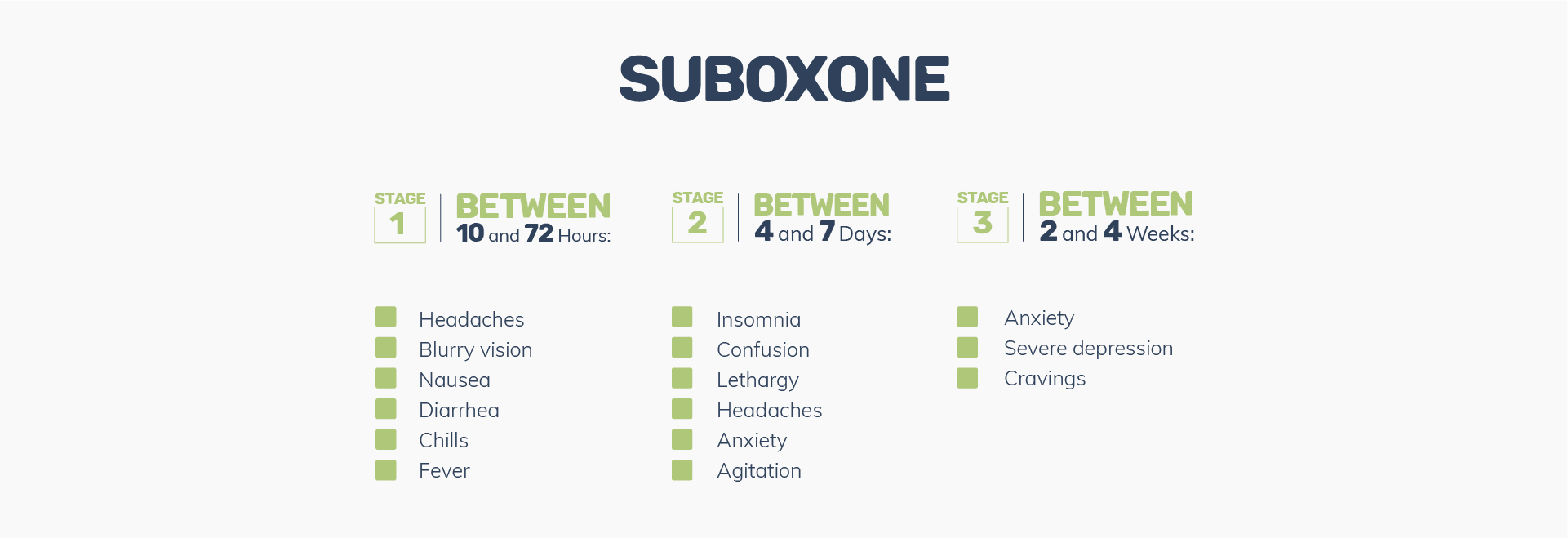
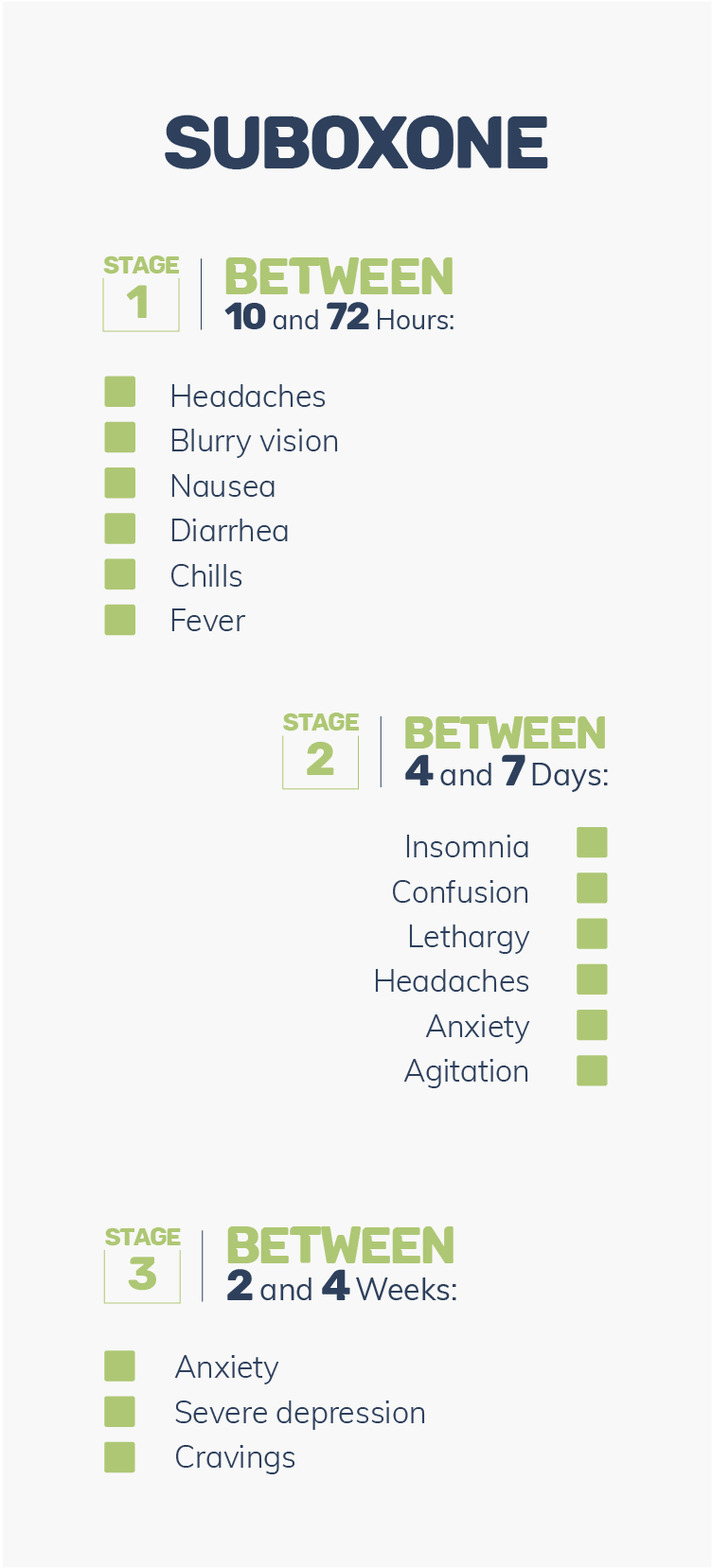
Like methadone, buprenorphine was originally developed as a painkiller with a low probability of causing addiction. When the medication did not live up to its potential for pain management, its British developers began marketing the drug as a treatment for opioid addiction, only to find that it did have a potential for abuse. Finally, in 2002 a new medication was released that contained both buprenorphine and the opioid-euphoria blocking drug naloxone. This combination was Suboxone; since then, it has shown to be a powerful treatment for opioid withdrawal with a lower abuse and overdose potential than any other alternative.
Suboxone does not cause a buzz if taken as directed, but if abused it may bring on feelings of well-being and relaxation.
Suboxone was developed to provide long-term relief against opioid withdrawal symptoms and cravings. Due to its long half-life, the withdrawal timeline for this medication can last weeks longer than other opioid drugs.
Stage One - Between 10 and 72 Hours:
Stage Two - Between 4 and 7 Days:
Stage Three - Between 2 and 4 Weeks:
The danger signs for buprenorphine and any other opioid are the same as those for heroin. See above.
There are no medications that specifically treat Suboxone withdrawal. Since the symptoms can be severe; it is not recommended to quit Suboxone cold turkey; rather a medically supervised tapering plan will be much more bearable and have greater chances of success.
Because the substance is designed to be long-lasting, the buprenorphine in Suboxone has a half-life of 35 hours or more. For this reason is is often detectable within the body for much longer than other opioids.
Anti-anxiety medications known as benzodiazepines or benzos present a potential for addiction on two fronts. On one hand, drugs like benzos are often glorified in hip-hop and pop culture, leading to widespread abuse by young people. Dependencies to these medications are not always formed by intentional abuse however. Many people with anxiety disorders can become accidentally addicted to benzos if they are prescribed to take them long-term. Either way, the withdrawal process from benzodiazepines is serious, and sometimes dangerous.

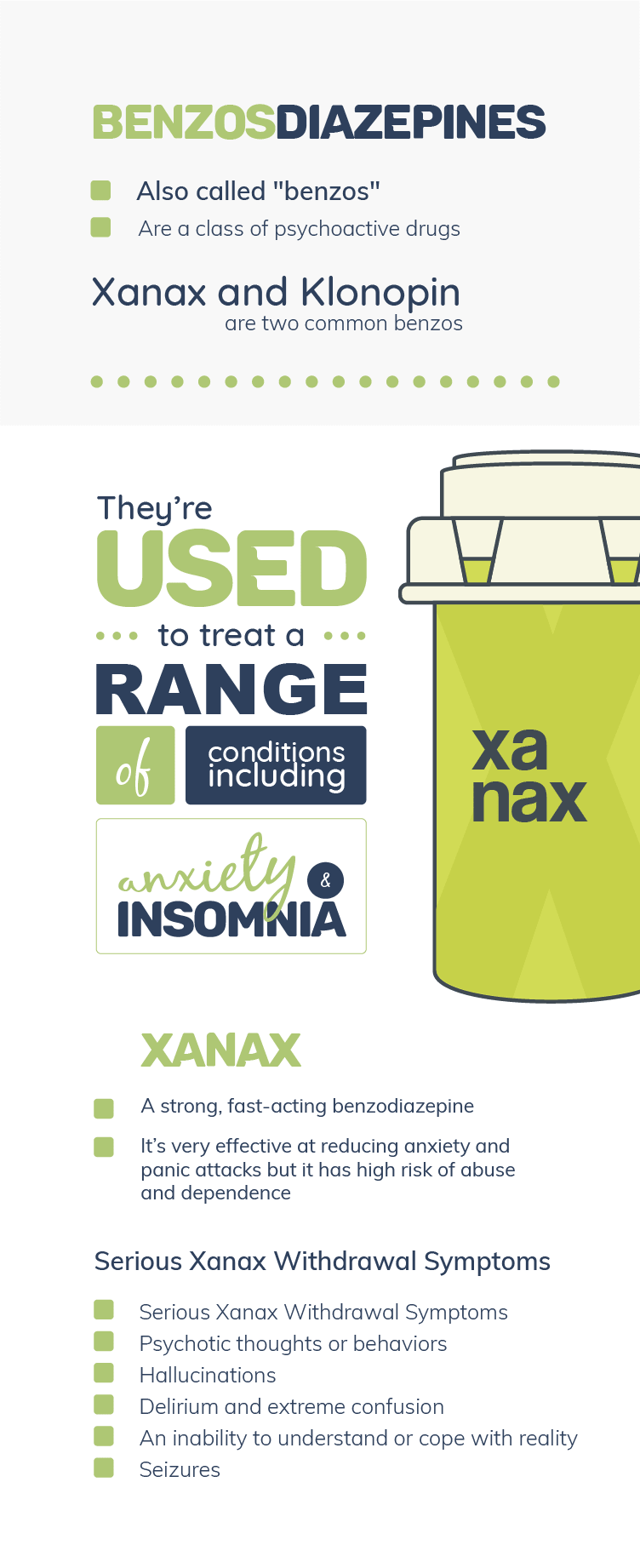
Xanax is a strong, fast-acting benzodiazepine intended for anxiety and panic disorders.
The medication was developed in the 1970s as a "less addictive" form of anti-anxiety pill. Needless to say, it turned out to be quite addictive after all. Although the medication is very effective at reducing anxiety and panic attacks, it brings a high risk of abuse and dependence as well.

Feelings of tranquility, calm, and lethargy
Stage One - Between 24 and 72 Hours:
Stage Two - Between 4 and 7 Days:
Stage Three - Between 2 and 4 Weeks:
After long-term or severe Xanax abuse, withdrawal symptoms can be severe to the point of life-threatening. If you or someone you know is going through Xanax withdrawal, be aware that the following symptoms will require emergency medical assistance:
Although there are no medications specifically targeting benzo withdrawal, some other types of anti-anxiety meds or antidepressants can soothe withdrawal symptoms. Here are some examples:
The Xanax half-life is about 11 hours, but it will remain detectable in the human body for the following lengths of time:
Like Xanax, Klonopin is a benzodiazepine intended to treat anxiety and panic disorders; however, Klonopin may also be effective at treating seizures.
The drug was developed in the 1960s specifically to treat seizure disorders, but it was soon discovered that Klonopin was also a useful remedy for anxiety. The medication is intended to last longer than other benzos and so its effects may feel more powerful if it is abused.
Mild euphoria, relaxation, drowsiness
Stage One - Between 1 and 7 Days:
Stage Two - Between 4 and 7 Days:
Stage Three - Between 2 and 4 Weeks:
Although physical symptoms will mostly fade by this stage, some serious side effects may develop in the late stage of klonopin withdrawal, such as agitation, hallucinations, or seizures.
The danger signs for Klonopin and any other benzo are the same as those for Xanax. See above.
The medications used to treat Klonopin withdrawal will be those same medications used for Xanax withdrawal. See above.
Klonopin has an extremely long half-life of up to 40 hours. For this reason it lingers in the body far longer than most drugs:
Sedatives and sleep aids include a range of medications that slow the central nervous system (CNS) in order to soothe the body or induce sleep. Even therapeutic use of these medications can lead to dependence, meaning that daily use of any type of sedative should be undertaken with great caution. Abuse of drugs like these is extremely dangerous and leads to even more severe withdrawal symptoms.
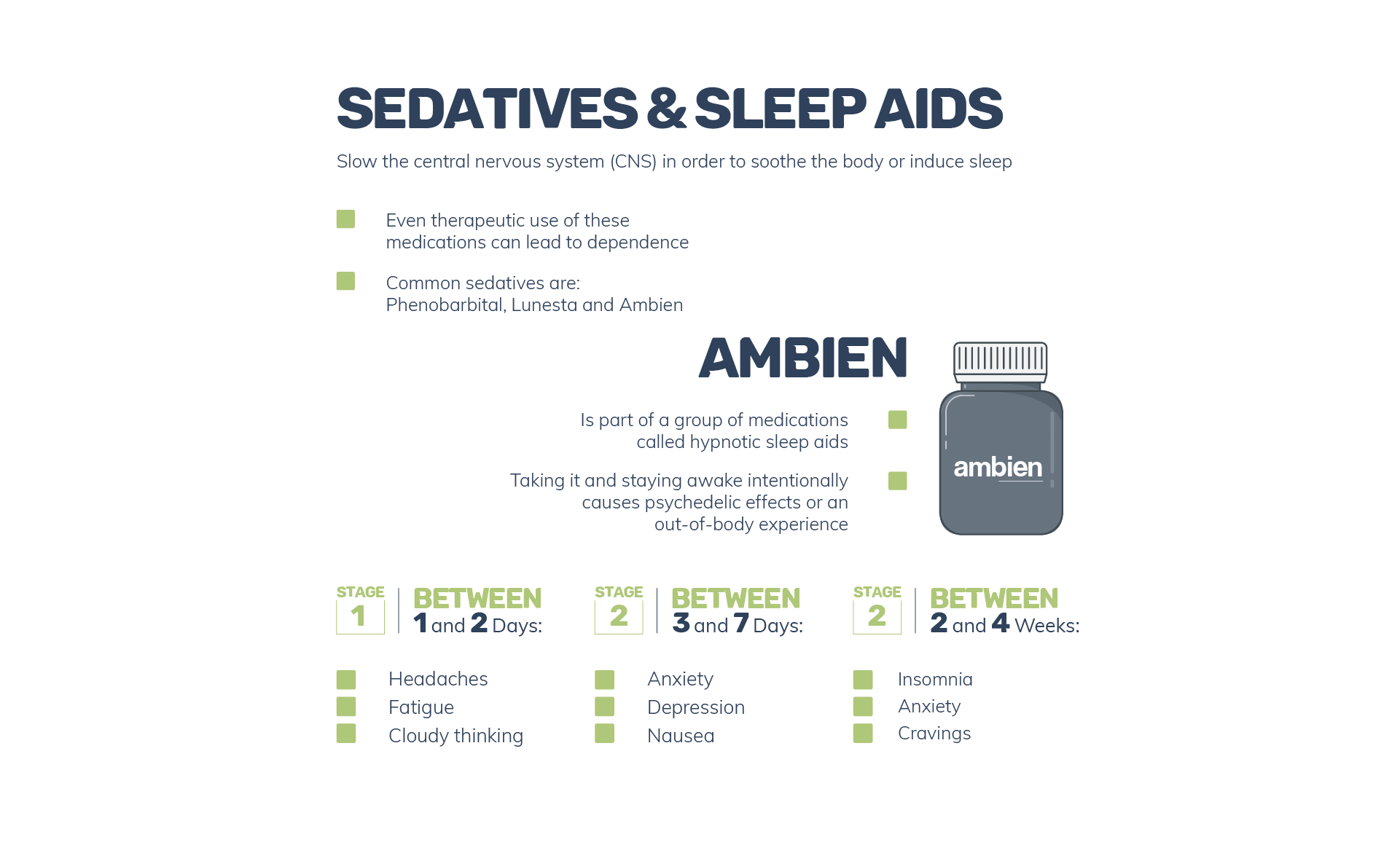
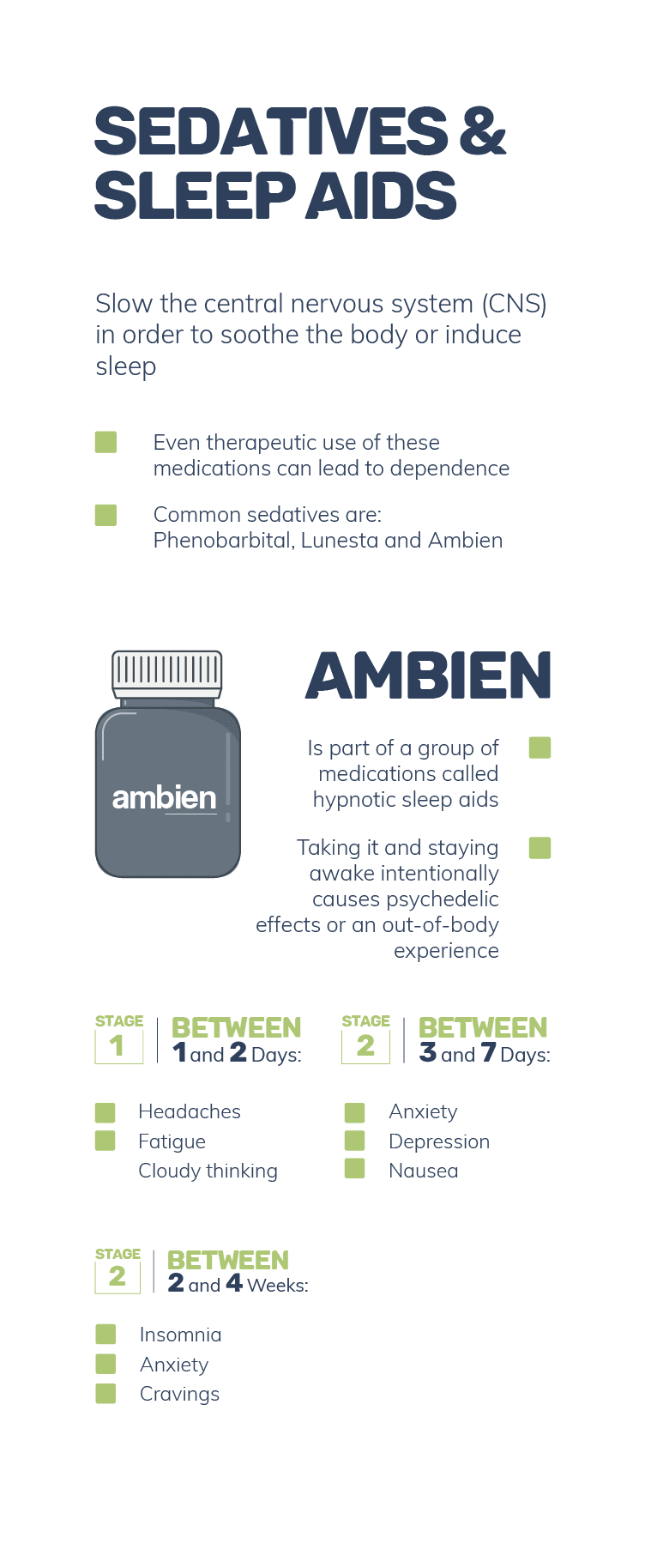
This sedative is part of a group of medications known as barbiturates. These drugs are rarely prescribed by modern-day doctors, except in cases of seizure disorders and certain types of severe insomnia.
Phenobarbital was developed in the early 1900s by a German chemist. Although it was occasionally prescribed for anxiety and insomnia in the 20th century, the medication quickly became famous for its effectiveness in reducing the seizures of epileptic patients. Today it is still mostly used for the treatment of seizures, but may be mixed with other drugs and abused for its relaxing sedative effects.
Sleepy relaxation, calm lethargy.
Stage One - Between 8 and 24 Hours:
Stage Two - Between 2 and 5 Days:
Stage Three - Between 6 and 15 Days:
The most significant danger of phenobarbital withdrawal is seizure. If you notice any signs of delirium or seizure during phenobarbital withdrawal, seek immediate medical attention.
There are no medications that specifically treat phenobarbital withdrawal, but a slow tapering of the drug is highly recommended. Quitting phenobarbital cold turkey can be life-threatening due to the probability of seizures. The safest way to do so is to slowly taper off of the drug while under the supervision of a doctor. Anti-seizure medications may also make the process safer.
Phenobarbital has an exceedingly long half-life of 70 - 80 hours. This means that it can be detected within the body for far longer than most other prescription drugs:
Ambien is part of a group of medications called hypnotic sleep aids that work by forcing the brain and body to slow and calm to the point of sleep.
Ambien was developed in 1980s Europe as an answer to chronic insomnia. It became popular worldwide in the 1990s but its potential for dependence was soon recognized. Even when used as directed, Ambien can be addictive. For people with substance use disorders, it is even more so.
The medication may also be abused if users take more than the recommended dose or if they abuse it in order to intentionally stay awake and experience hypnotic hallucinations or waking dreams.
Most people do use Ambien in order to fall asleep, in which case it would not produce a conscious buzz, but if you take it and stay awake intentionally, you may notice psychedelic effects or an out-of-body experience.
Stage One - Between 1 and 2 Days:
Stage Two - Between 3 and 7 Days:
Stage Three - Between 2 and 4 Weeks:
In some severe cases, Ambien withdrawal can result in psychotic symptoms or seizures. These are examples of withdrawal symptoms that would be considered medical emergencies:
The most common medical recommendation for Ambien withdrawal is to wean off of the drug slowly. Many medical detox programs do not use medications to treat Ambien withdrawal unless the symptoms are severe or dangerous. In these cases, some prescriptions that could be useful include:
The Ambien half-life is only 1.5 hours, although its effects can be felt for up to 8 hours. This is how long it remains in your body:
Lunesta, like Ambien, is also a hypnotic sleep aid and works in much the same way.
Lunesta is a relatively new drug and, although it works in the same way as Ambien, it may have slightly less potential for abuse than Ambien, since it rarely causes any type of euphoria or psychedelic effect. Most Lunesta addictions develop when the user feels completely unable to fall asleep without the drug and continues to it after the prescription has expired or uses more than the recommended amount.
Although a few cases of hallucinations or psychedelic effects have been reported when Lunesta is abused, it is mostly used solely with the intention of falling asleep; therefore, it does not usually cause a buzz or euphoria.
Stage One - Between 24 and 48 Hours:
Stage Two - Between 2 and 7 Days:
Stage Three - Between 7 and 10 Days:
There are no known medications to treat Lunesta withdrawal, although a non-sedative sleep aid may be recommended for rebound insomnia.
Lunesta has a half-life of 6 hours, but it flushes out of the body relatively repaidly:
Steroids are part of a class of substances known as performance-enhancing drugs. When abused in this way, anabolic steroids act as synthetic testosterone to increase athletic performance.
When it was discovered that anabolic steroids could be used as synthetic testosterone in the 1930s, doctors mostly employed the drug as a remedy for men who did not produce normal levels of their own testosterone. In World War II, soldiers and military commanders discovered that steroids could be used to increase muscle mass and performance; from there the drug gained great popularity in the sports sector.
Over a million adults in the United States abuse steroids; that does not include the alarming number of high school and middle school students who also use steroids to increase their performance on sports teams.
Steroids do not produce a euphoric high, but they do increase muscle mass, strength, endurance, and overall athletic performance.
Stage One - First 24 Hours:
Stage Two - Between 2 and 6 Days:
Stage Three - Between 5 and 14 Days:
Most symptoms will fade during this interval but cravings may persist longer.
Generally, anabolic steroids will be tapered down over time with no need for additional medications. However, if the addiction was long-term or severe, the following medications may help with withdrawal symptoms:
The half-life of anabolic steroids varies greatly from one type of steroid to another. Depending on what kind of steroid you are taking, the half-life may vary anywhere between 6 hours and 14 days. Because of these variables, the amount of time the drugs linger in your system will also vary, but here are some very general guidelines:
Hallucinogens are a class of drug all their own and include substances like LSD, ketamine, DMT, and psilocybin "magic" mushrooms.
Natural psychedelic substances like peyote and magic mushrooms have been in use for thousands of years, but synthetic hallucinogens like LSD have only been produced since the beginning of the 20th century. While some psychedelics do not create dependence, it is possible to become addicted to drugs like ketamine and PCP.
Hallucinations (obviously), out-of-body experiences, visions, and euphoria
Stage One - First 24 Hours:
Stage Two - Between 2 and 3 Days:
Stage Three - Between 4 and 8 Days (In rare cases):
Hallucinogen withdrawal is almost always psychological in nature, so occasionally anti-anxiety meds or antidepressants are prescribed to treat these symptoms.
Most hallucinogens have a short half-life between 1 and 3 hours, so they tend to leave the system relatively quickly:
It is difficult to throw MDMA (ecstasy) into any particular class of drugs since it exhibits hallucinogenic, euphoric, and stumaltive properties all at the same time. Most would consider it to be a "club drug".
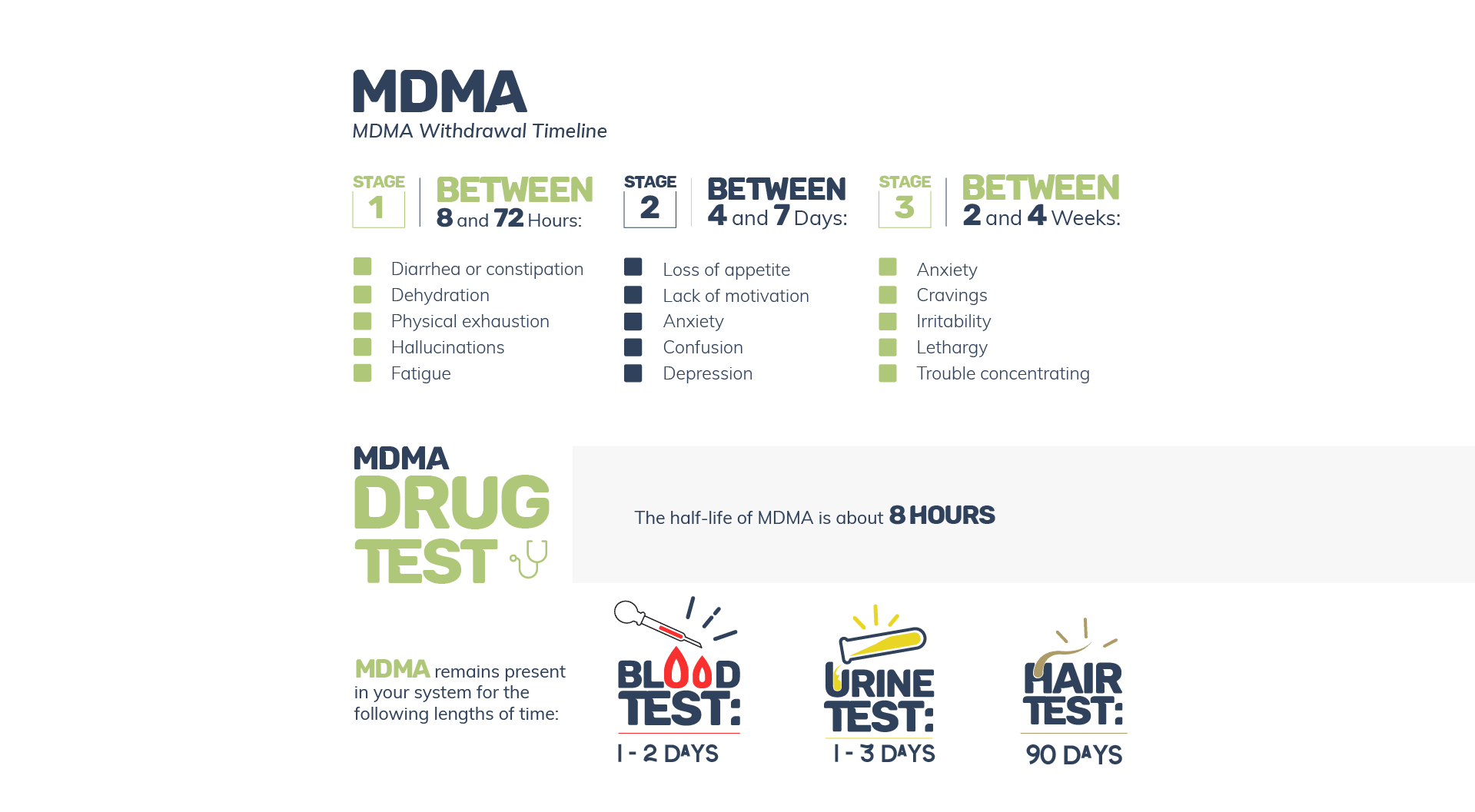

Ecstasy was created in the early 1900s but no one was able to find a use for it until psychiatrists and military doctors began experimenting with its psychoactive effects. It did not become popular for recreational purposes until the 1980s when ecstacy began to gain traction within the budding electronic music scene. Since then, the drug has become synonymous with rave parties, music festivals, and electronic trance music.
Powerful euphoria, sensitivity to sensory perceptions, happy empathetic response to other people
Stage One - Between 8 and 72 Hours:
Stage Two - Between 4 and 7 Days:
Stage Three - Between 7 and 14 Days:
In most cases, the only medications needed during MDMA withdrawal are antidepressants to replenish depleted serotonin levels.
The half-life of MDMA is about 8 hours and it will remain present in your system for the following lengths of time:
It is important to note that the time tables listed above for withdrawal and drug test detectability are highly subject to change. Physiological factors like metabolic rate, diet, and the overall health of your body will all have an effect on how your body flushes out substances and detoxes itself.
The key to completing drug withdrawal successfully will be the methods you use to manage withdrawal symptoms. A professional drug detox facility provides the following methodologies to treat and soothe withdrawal symptoms:
Medication-Assisted Treatment - Through the use of targeted medication protocols, medical personnel can reduce and even prevent many withdrawal symptoms and cravings, making the process more bearable.
Holistic Activities - Activities like yoga, exercise, massage, and meditation can be enormously helpful during detox, both for psychological symptoms and to help the body flush out toxins.
Counseling and therapy - Although a rigorous counseling schedule is not recommended during the withdrawal stage, counseling and emotional support are helpful for psychological symptoms.
Vitamin and Nutrition Replacement Therapy - If prolonged drug use has left your body malnourished and unhealthy, withdrawal symptoms will be even more severe. Nutritional replenishment is important to strengthen your body and immune system.
If you've read this far, you will have noticed several warnings in this article about the dangers of going through withdrawal without medical supervision or doing it "cold turkey". That's because some types of drug withdrawal can actually be life-threatening. Here are some reasons why quitting cold turkey and unsupervised is never a good idea:
Successfully completing the drug or alcohol detox process is a huge step; one that you should be proud of, but it doesn't mean you're out of the woods. Drug withdrawal is the process of shedding your physical dependence, but addiction goes much deeper than the physical.
Only about 15% of recovering addicts who go through drug detox alone will continue on to maintain sobriety. That's because you have to address both sides of addiction - the physical and the psychological.
Once your body has completed detox, you'll be physically prepared for drug rehab - the process of uncovering the psychological causes of your addiction and learning how to cope with the daily challenges of substance use disorder.
Drug rehab is the next step of recovery, and it will help you to explore the reasons behind addiction, such as an emotionally traumatic past or underlying mental health conditions. The underlying factors of addiction must be addressed head-on if you hope to move past them and achieve a healthy, long-lasting recovery. It is also important to learn everyday coping mechanisms to address triggers and cravings that could affect you at any time in the future. Through a combination of psychiatric evaluation, therapy, counseling, and education, drug or alcohol rehabilitation will provide you with the tools you need to build your own future in recovery.
No matter what your substance of choice is, you now have an idea of what the withdrawal process has in store. You've probably realized that it won't be easy or pleasant. This may be the most difficult thing you will ever do. But there is hope.
There are teams of trained professionals waiting to help people like you get through withdrawal in the most comfortable way possible. It doesn't have to be as hard as it looks in the movies. Help is waiting; all you have to do is ask for it. Make the leap, and start your Day One.

Our admissions coordinators are here to help you get started with treatment the right way. They'll verify your health insurance, help set up travel arrangements, and make sure your transition into treatment is smooth and hassle-free.
[DirectNumber] Contact Us